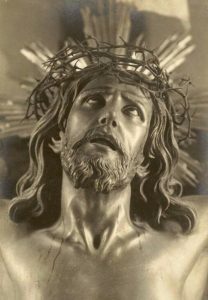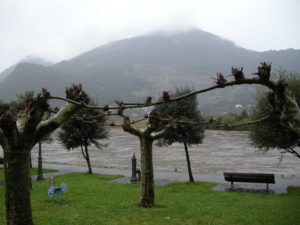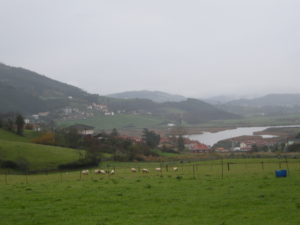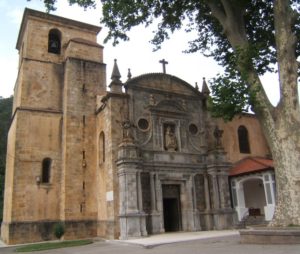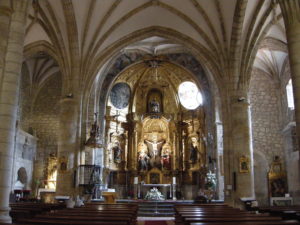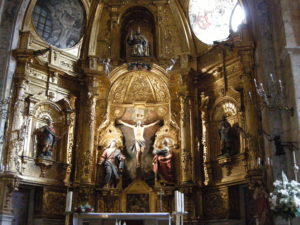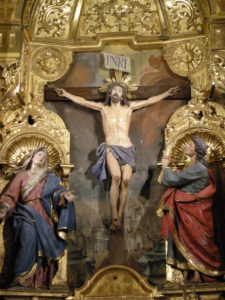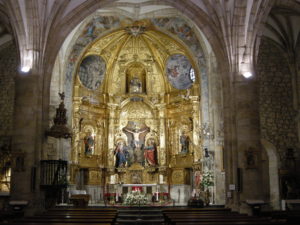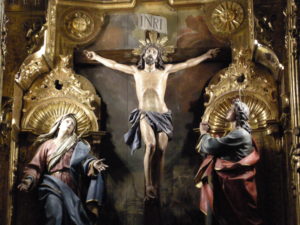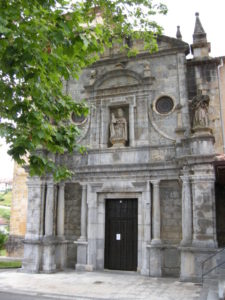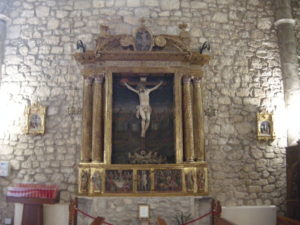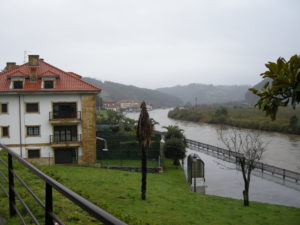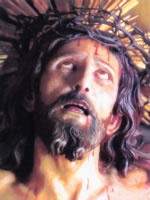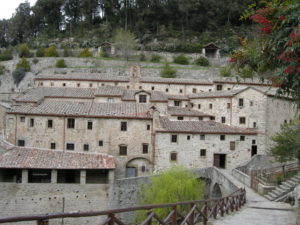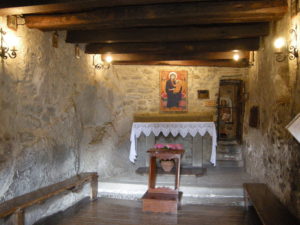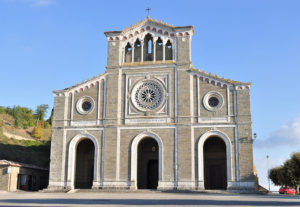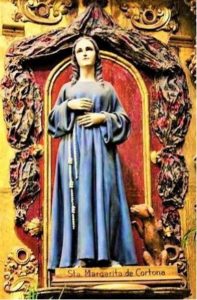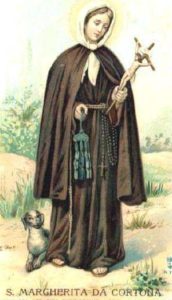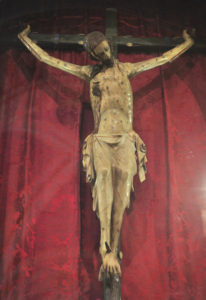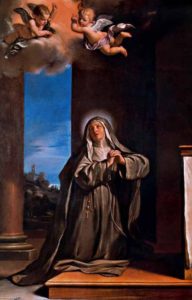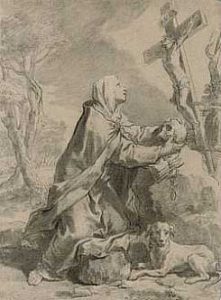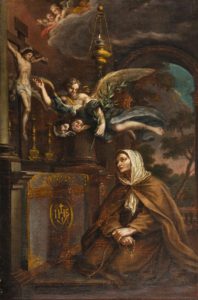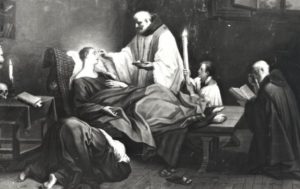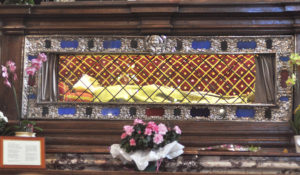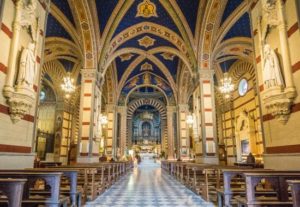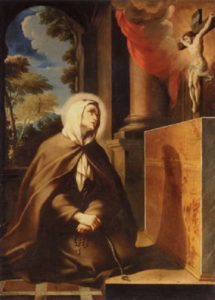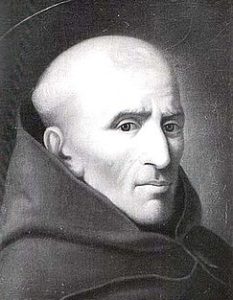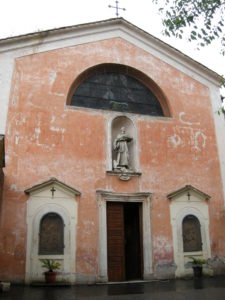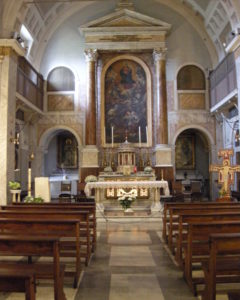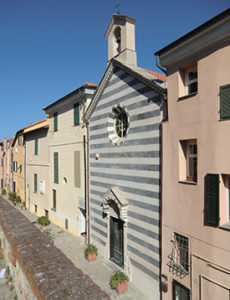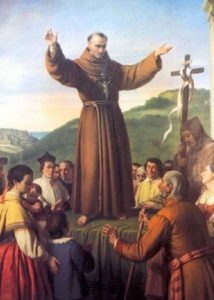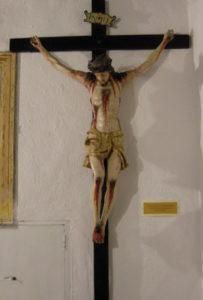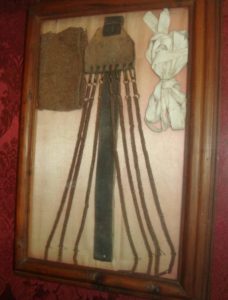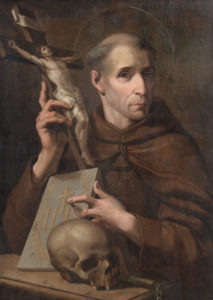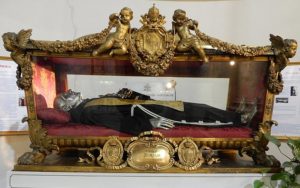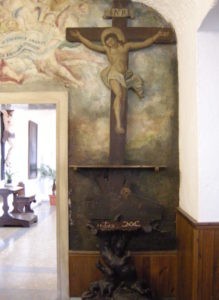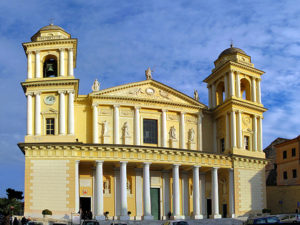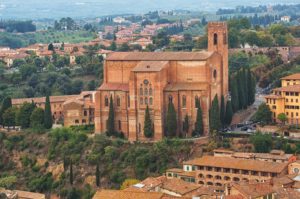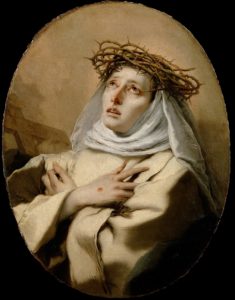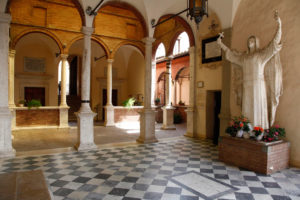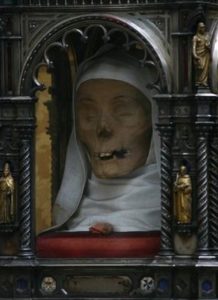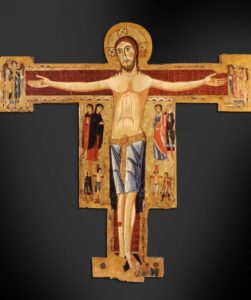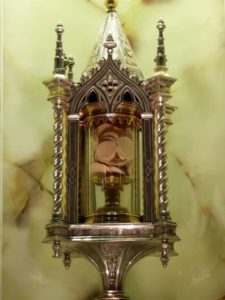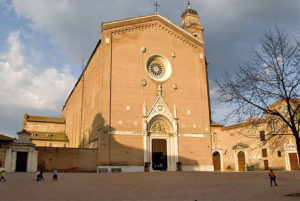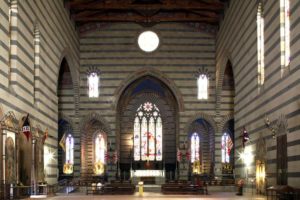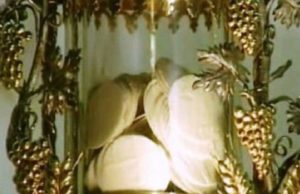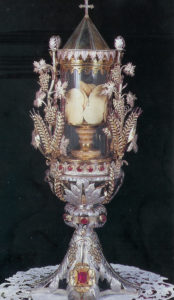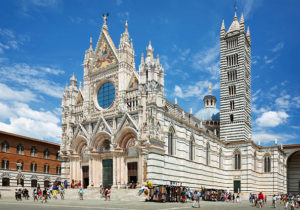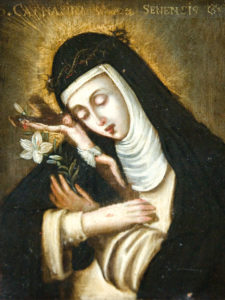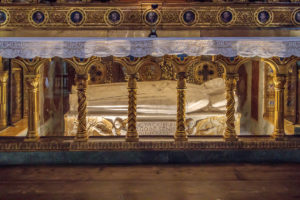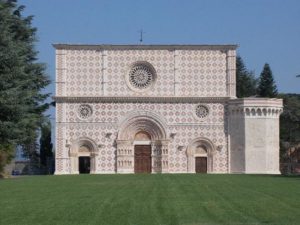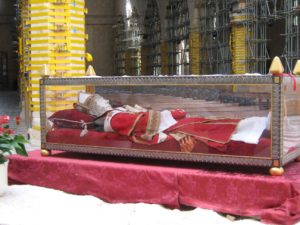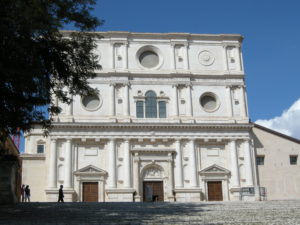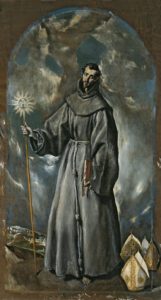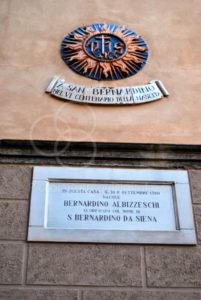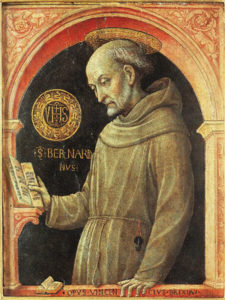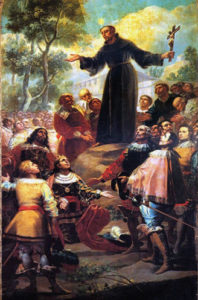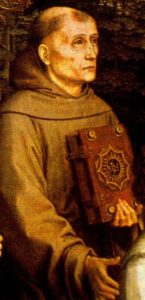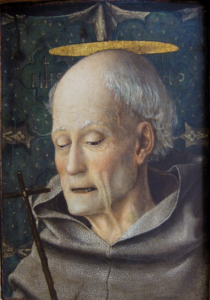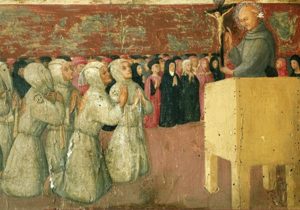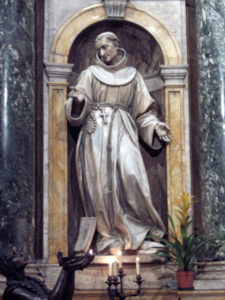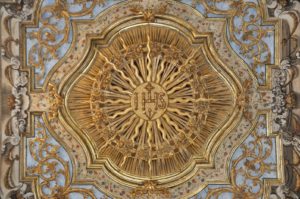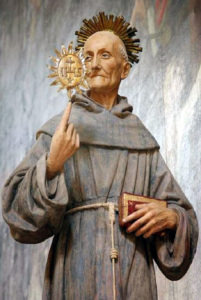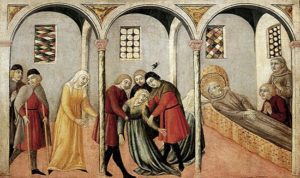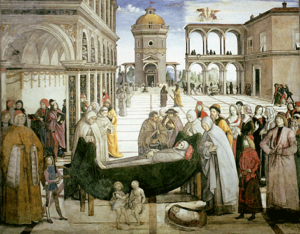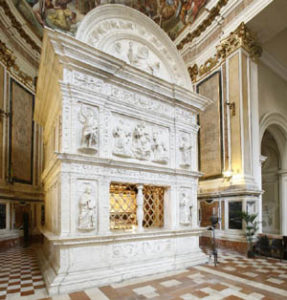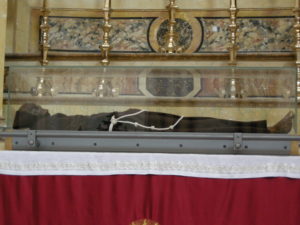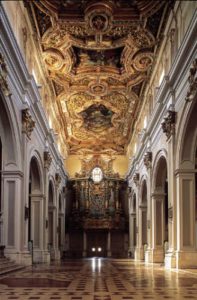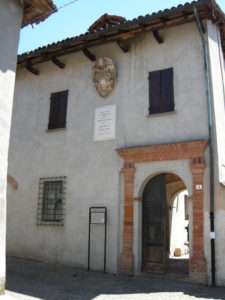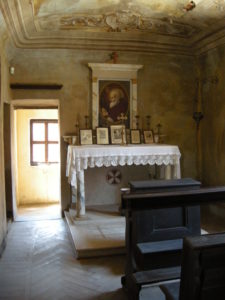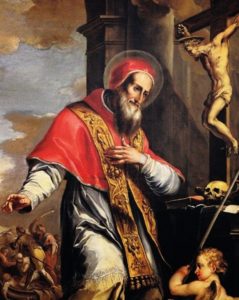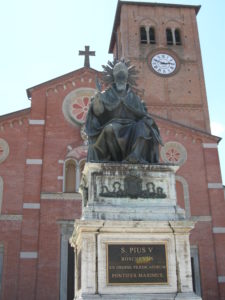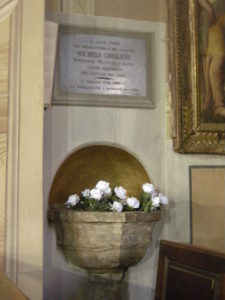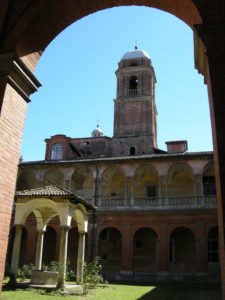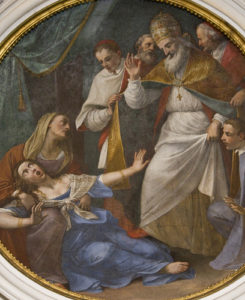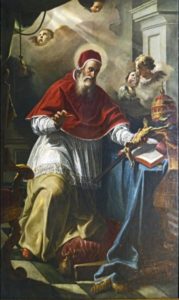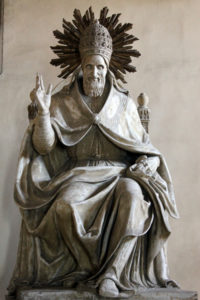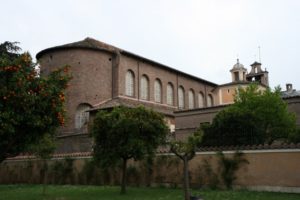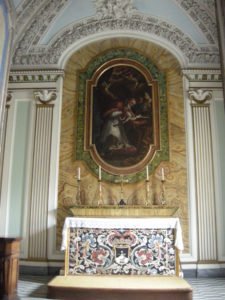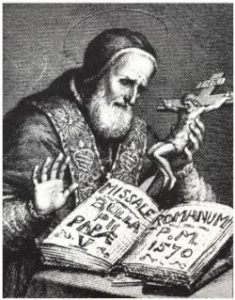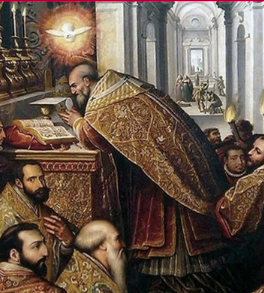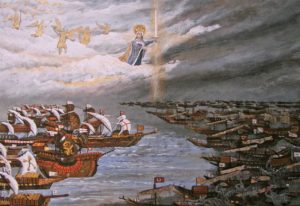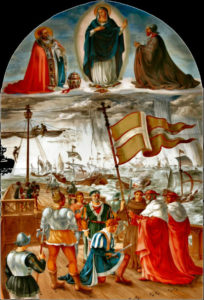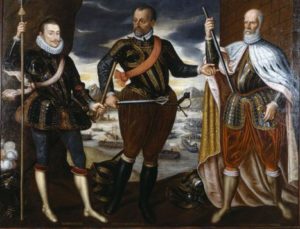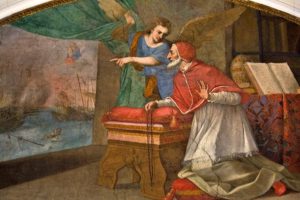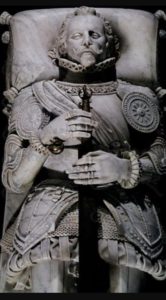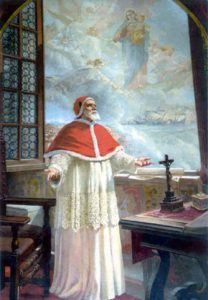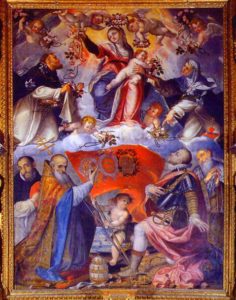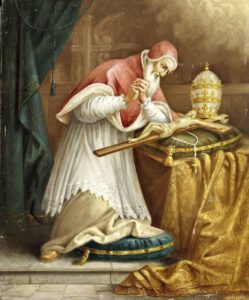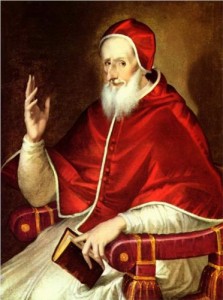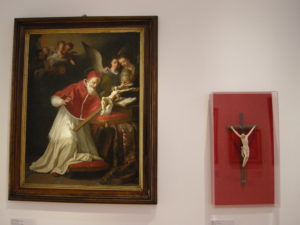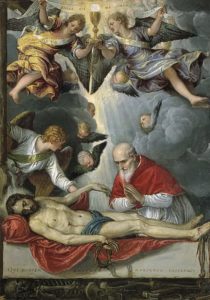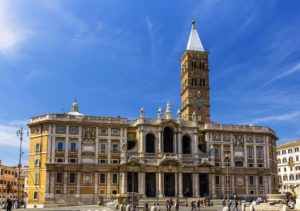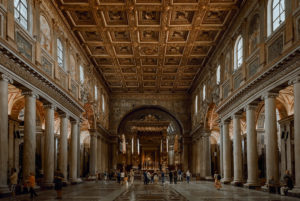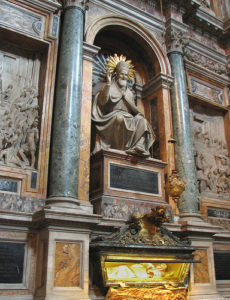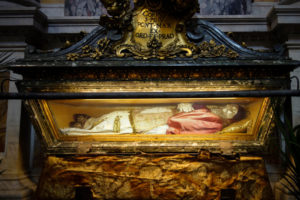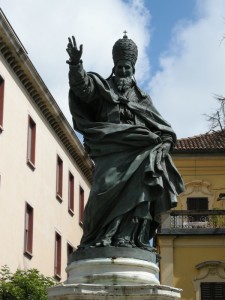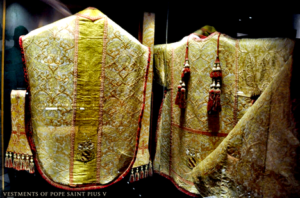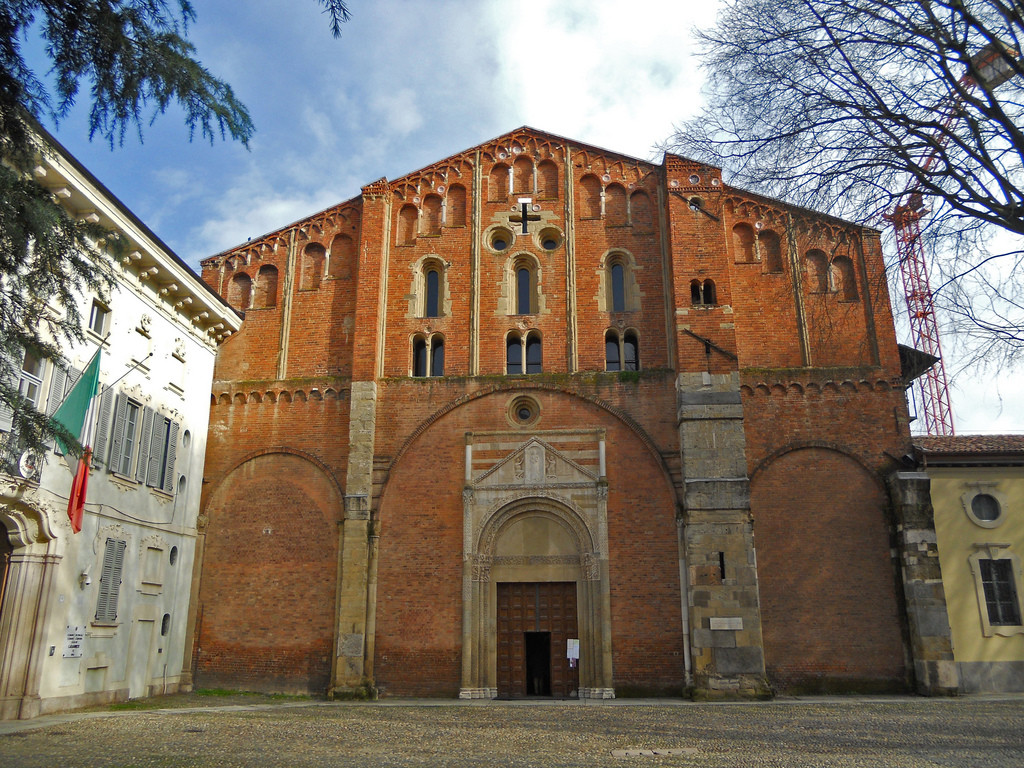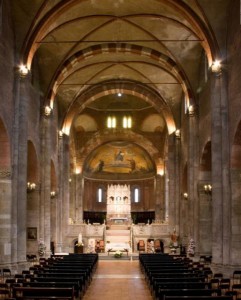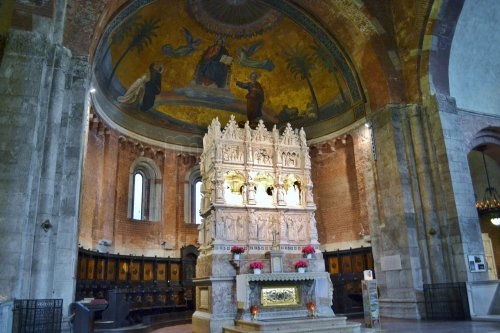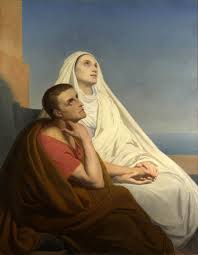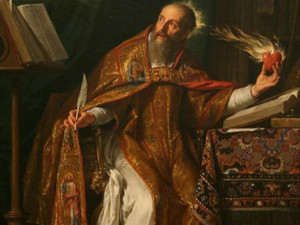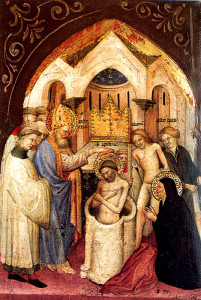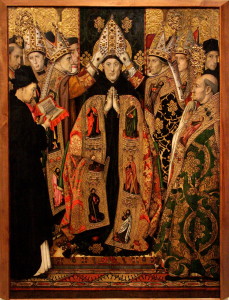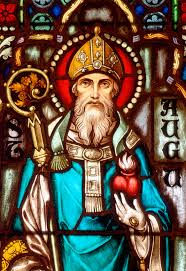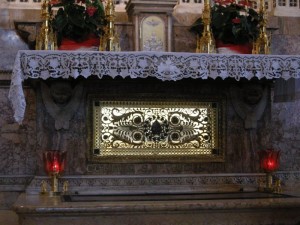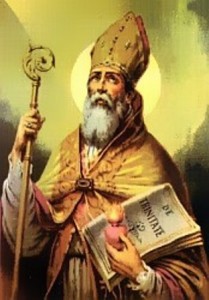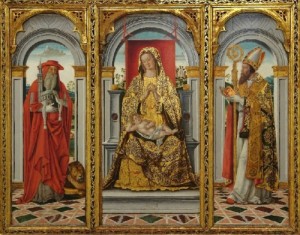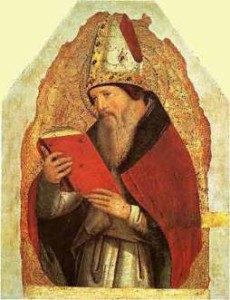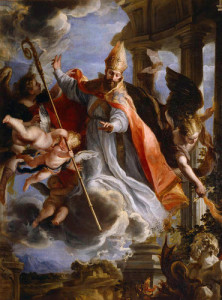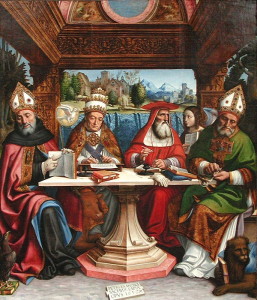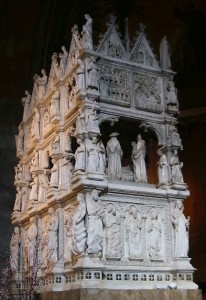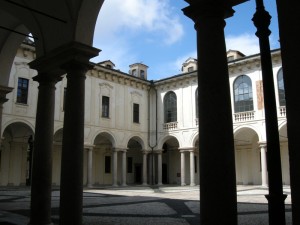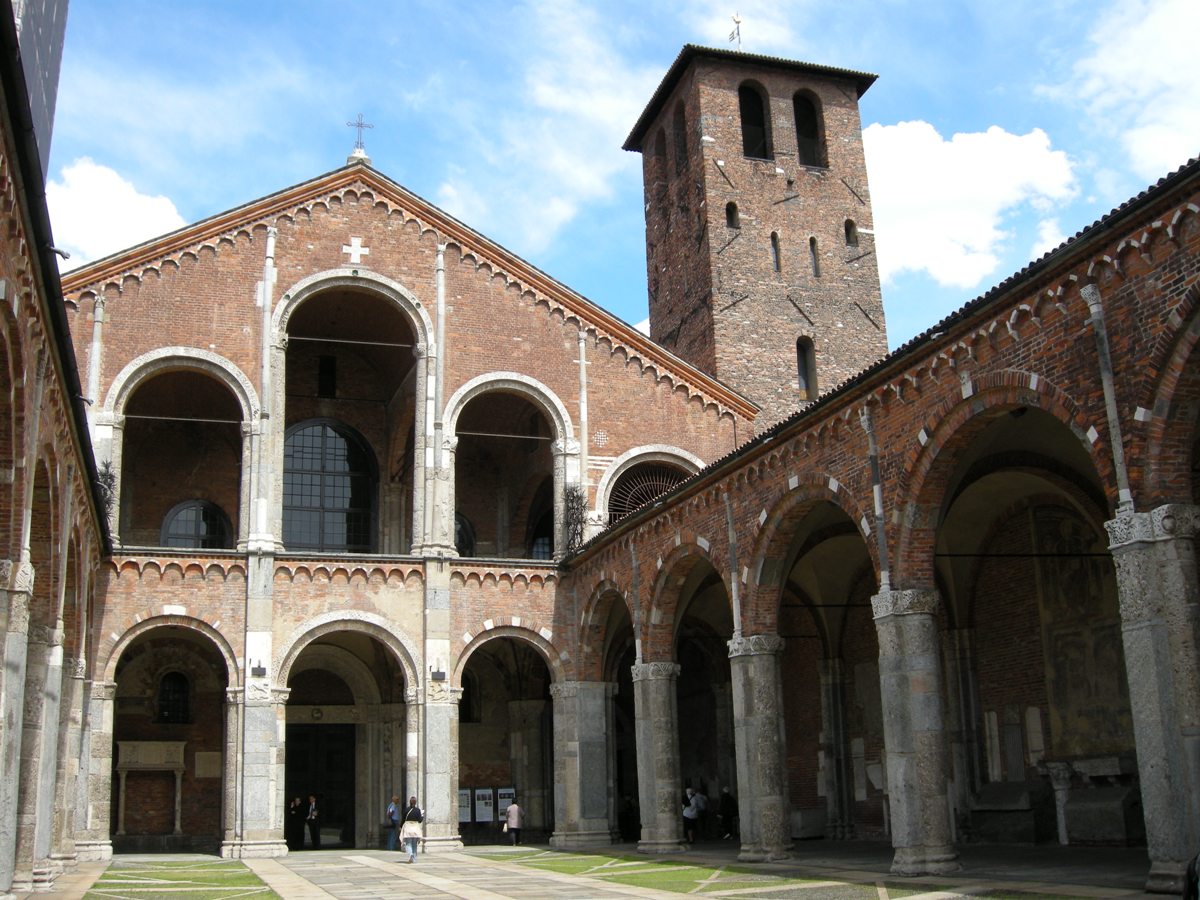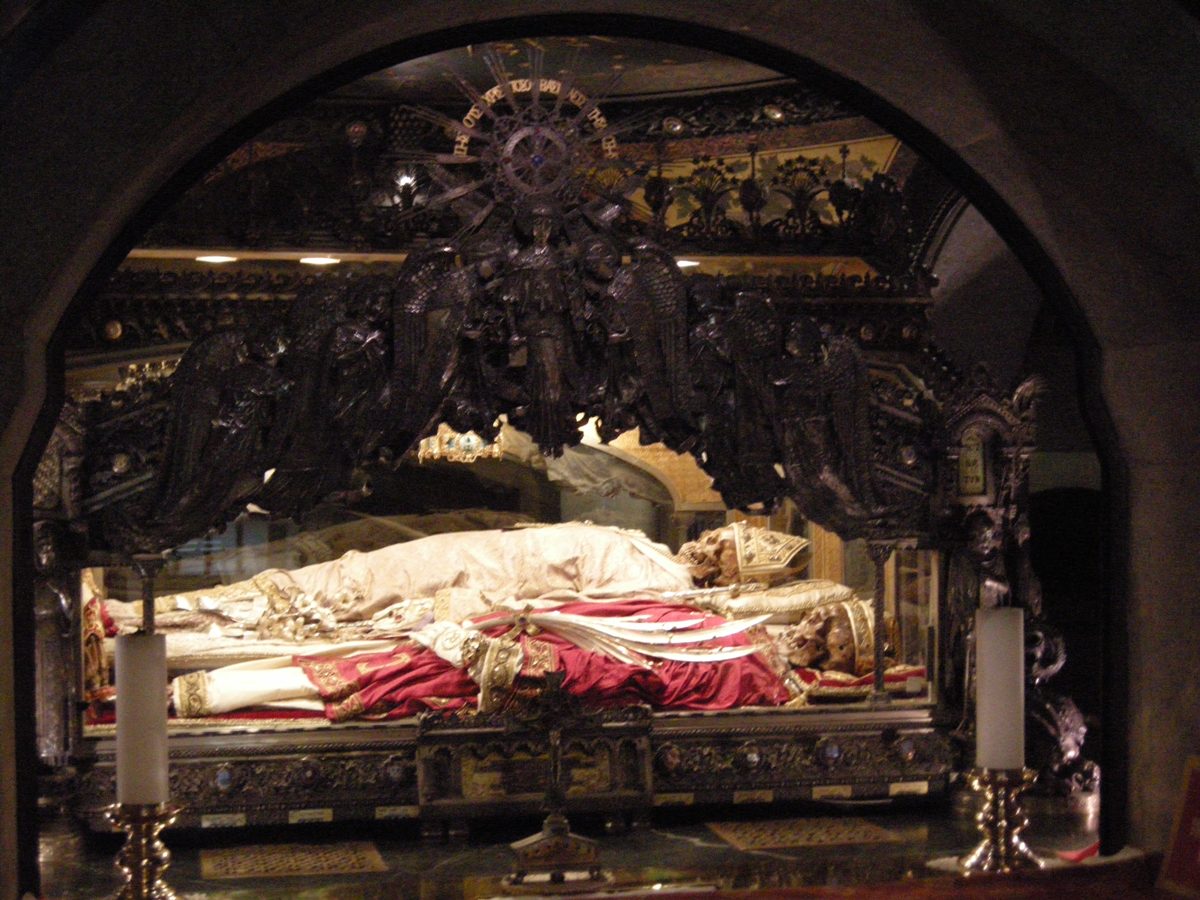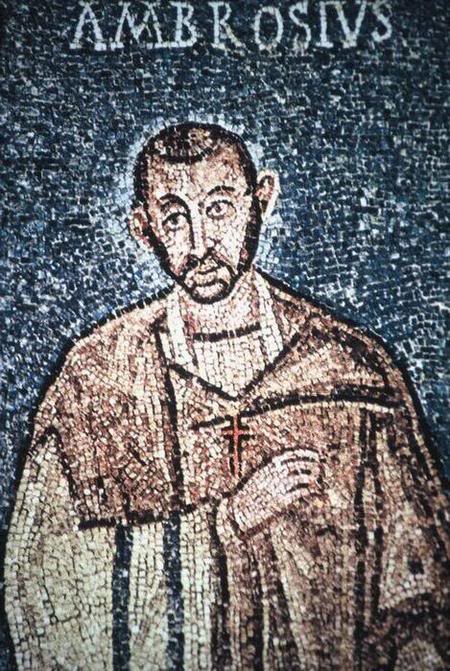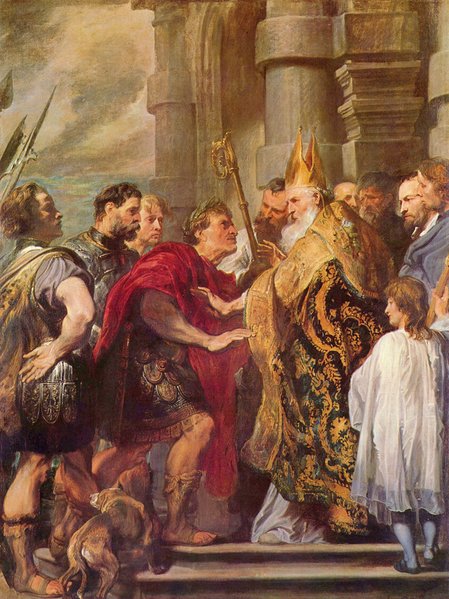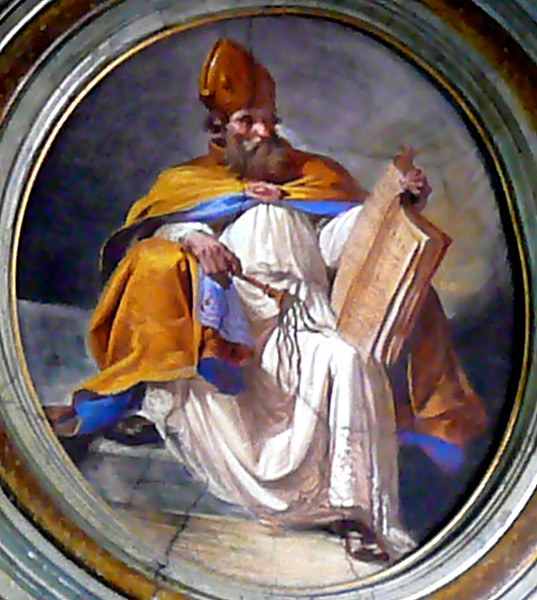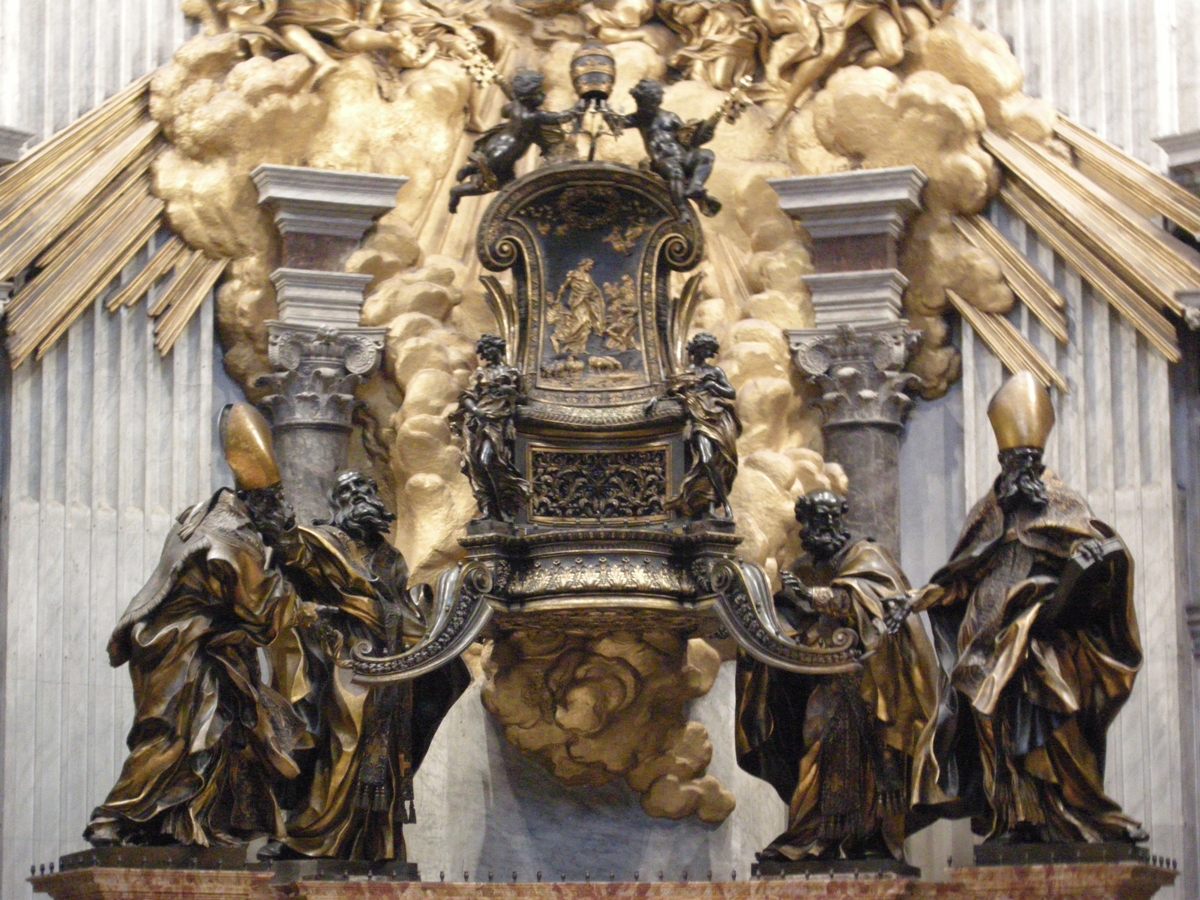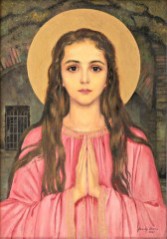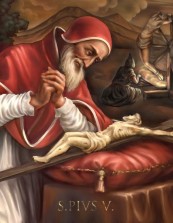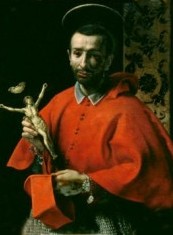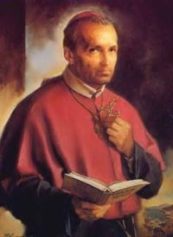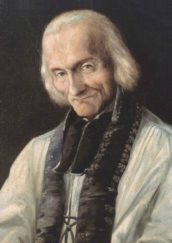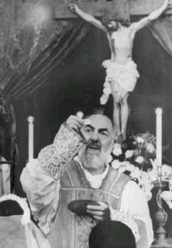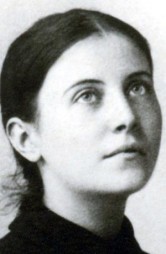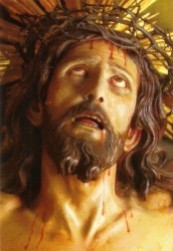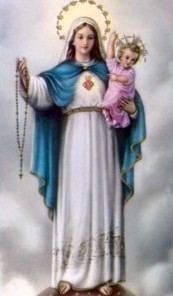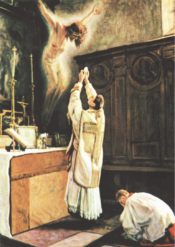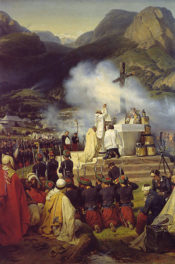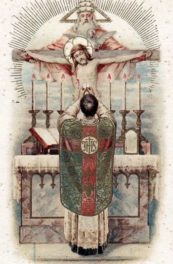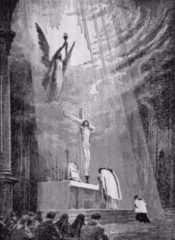Milan: Saint Charles Borromeo
Duomo (Piazza del Duomo 18; 7am-7pm; www.duomomilano.it)
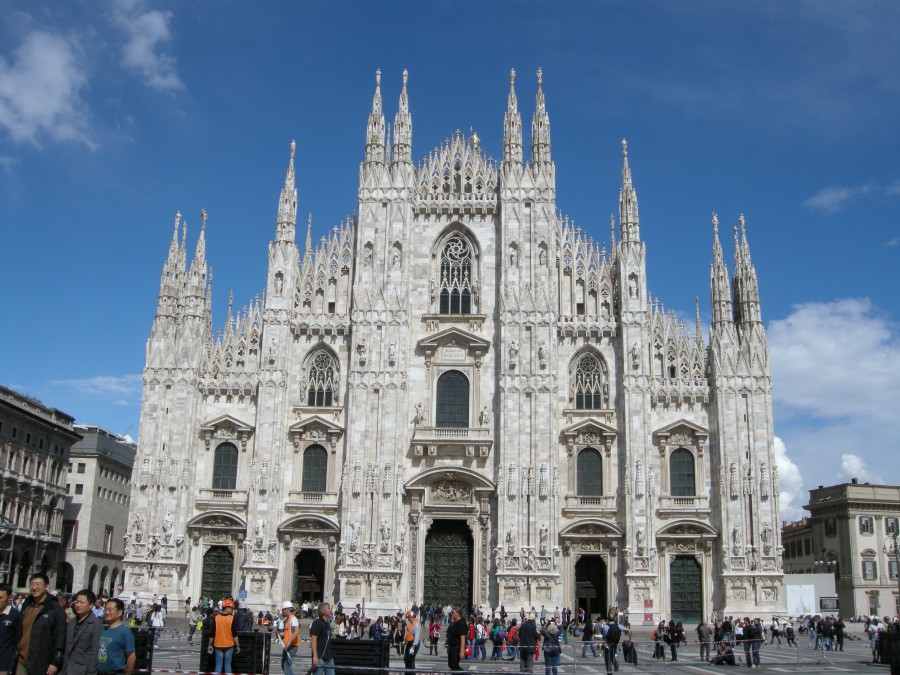
Duomo, Milan
The Duomo (Cathedral) of Milan is the largest Gothic cathedral and third largest Catholic church in the world; it can easily accommodate over 40,000 people. Construction began in late 14th century and carried on until early 19th century. Beneath the Duomo are the excavated remains of a 4th century early Christian baptistery (Battistero di San Giovanni alle Fonti), considered to be the place where St. Ambrose baptized St. Augustine in 387. The ruins of two old basilicas from the times of St. Ambrose can also be seen in the excavations.
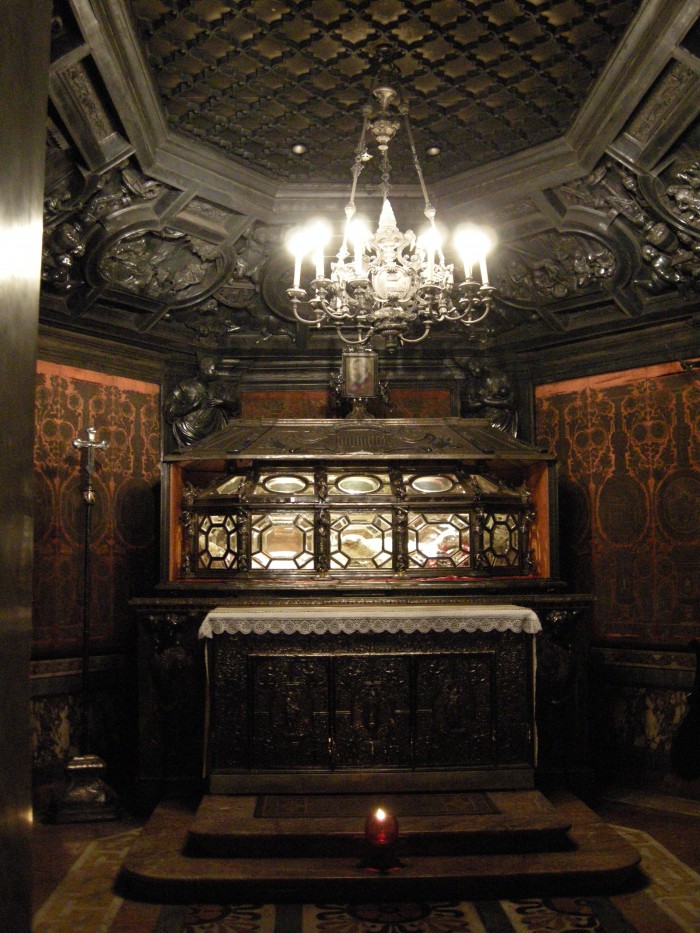
Duomo, crypt – St. Charles Borromeo
Having seen the Duomo on prior visits, I headed straight to the crypt where St. Charles Borromeo, the 16th century cardinal archbishop of Milan and great saint of the Counter-Reformation, lays in a crystal coffin.
Given the popularity of the cathedral with tourists from all over the world wringing a few minutes of prayer at St. Charles’ tomb required a constant battle with the deluge of cameras shoved into my face even in front of the saint’s very remains. The visitors appeared oblivious of whose relics were before them, or else their knowledge did not induce them into behaving with any more respect. (This, sadly, is a common scene at holy places and shrines in most parts of Europe; with the abandonment of the faith piety, decency and respect went right out of the window, which is particularly notable in churches and even in front of the Blessed Sacrament.)
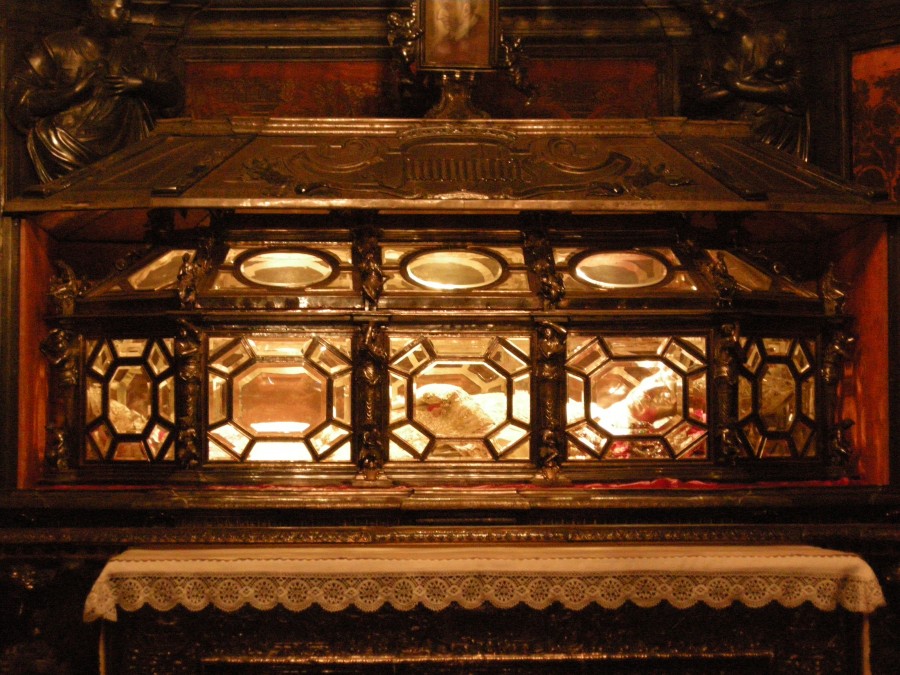
Relics of St. Charles Borromeo (Duomo, Milan)
A sketch of the life and achievements of this great man follows below. If this appears somewhat extensive for a blog post, I nevertheless hope you may read it, in honor of this remarkable saint who is a worthy role model for faithful Catholics in our own troubled times. Links to (free to download) biographies of St. Charles are at the end of this post.
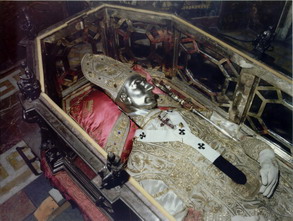
St. Charles Borromeo
St. Charles Borromeo, one of the most important saints not just of the Counter-Reformation but of all Church history, and the perfect model of a prelate, can inspire and teach us much today. May the Lord, in these terrible times of widespread apostasy and depravity, grant His Church holy men in the mold of Saint Charles.
SAINT CHARLES BORROMEO – A LIFE FOR THE CHURCH
Charles Borromeo was born in 1538 at the castle of Arona (near Milan) to a very wealthy aristocratic family. The birth of the boy who was to become a glorious saint was announced by a brilliant light that appeared above the castle, illuminating the night from two in the morning, the time of his birth, until daybreak (as confirmed under oath by multiple witnesses in the canonization process).
His parents were known for their piety and virtuousness, which young Charles imitated from early age. Being of an earnest disposition he shone amusements and preferred to spent time in prayer and listening to the reading of devout books. Only 12 years old he received the tonsure of minor orders. When his uncle, around that same time, turned over to him a wealthy Benedictine abbey (one of the benefices held by the family), Charles insisted the revenues belonged to the Church and the poor and, except for the minimum necessary for his studies, could not be used for any other purposes.
Due to a speech impediment (which he would only overcome many years later) and his love of silence he was considered by many to be slow of mind. However, he loved to study and at the age of 16 was sent to the University of Pavia to study civil and canon law. Then, as today, universities were known for corrupt morals; debauchery reigned among most of his fellow students. Charles would immediately flee from even the slightest occasion of sin and retire to his prayers and devotions, which often earned him ridicule and sneers. Caring little for the derision of the world and preferring the friendship of God to that of men, he begged the Lord to keep his soul from evil and harm. Rejecting two of his tutors – priests he considered too secular, lax in saying their office, and improperly dressed as laymen instead of wearing clerical attire – young Charles showed his prudence and good judgement.
Cardinal and Secretary of State
Soon after earning his doctorate Charles received the news that his uncle, cardinal Giovanni Angelo di Medici, had been elected to the papacy (after the death of Paul IV). The new pope, who took the name Pius IV, summoned his nephew to Rome and, in short progression, made him cardinal, administrator of the archdiocese of Milan, and Protector of Portugal, the Low Countries, the Catholic cantons of Switzerland as well as of the Carmelites, Franciscans and the Knights of Malta, among other offices. He also entrusted Charles, still only 23 years old, with the administration of the Papal States.
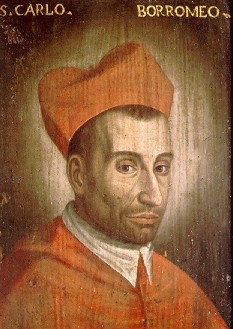
Despite the heavy burden of the multiple tasks the energetic and diligent young man performed them admirably, while never neglecting his prayer, devotions and sacred studies. Surrounded by wealth and honors, St. Charles – in his heart increasingly austere, humble and disengaged from worldly things – not only did not find enjoyment in them but saw the dangers they presented to the soul. Longing for monastic life of contemplation and penance, lived only for God and far from the world, the young cardinal sought advice of the venerable archbishop of Braga, who counselled him to stay in Rome in service of the Church. Accepting this as God’s will, St. Charles would spend the rest of his life untiringly laboring for the good of the Church and the advancement of Christ’s Kingdom.
When his older brother unexpectedly died in late 1562, Charles, as the remaining male heir of the Borromeo family, was urged to abandon his ecclesiastical offices and marry. He, however, seeing the futility of worldly pursuits, decided to live henceforth only for Christ. The following year, after giving up most of his estates and benefices, he was ordained priest and, three months later, consecrated bishop. In 1564 he became archbishop of Milan but, being needed by the Pope in Rome, wasn’t permitted to take up residence in his archdiocese until two years later.
Apostle of the Council of Trent
Pius IV, at the insistence of his nephew, reconvened the Council of Trent, which had been interrupted for the previous ten years. Under the skilful organization and zealous oversight of cardinal Borromeo the great Council was successfully concluded by the end of 1563. It condemned Protestant heresies and clarified and confirmed Catholic dogmas and doctrines – particularly those that had been disputed by the Protestants. It also anathematized anyone who denied these doctrines. [Modern-day Catholics would be well advised to have a look at these anathemas, for the things condemned by the sacred Council – and by any Council from Nicea to Vatican I – are the very same that multitudes of those who claim to be Catholic believe, propagate and practice today.]
The Council also instituted reform of education, life and discipline of the clergy and religious, tightened organization of religious institutions, and clamped down on various ecclesiastical abuses and excesses which had become widespread in the Renaissance Church. The texts of the Council of Trent can be read here: http://history.hanover.edu/texts/trent.html
St. Charles also supervised the compilation of the Catechism of the Council of Trent (issued by St. Pius V; here is the pdf version of the Church’s finest, soundest and most complete catechism), the Missal and the Breviary.
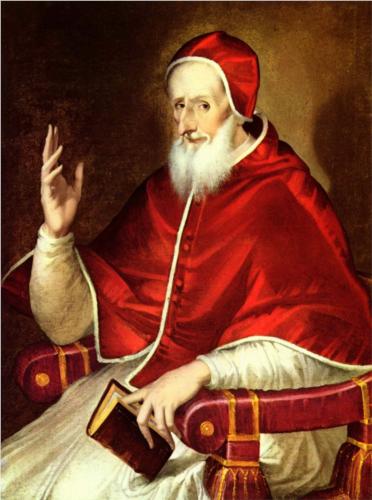
Pope St. Pius V
Upon the death of his uncle Pope Pius IV, cardinal Borromeo wholeheartedly supported the Dominican friar and cardinal of Alessandria, Michele Ghislieri, who was noted for his holiness and zeal. The other cardinals followed his advice and Ghislieri was raised to the throne of St. Peter, taking the name of Pius V. (St. Charles put all personal interests and considerations aside, for relations between his uncle Pius IV and cardinal Ghislieri had been far from amicable, and did what he knew to be best for the glory of God, the Church and salvation of souls.) Charles held Pius V in great esteem and veneration and wrote, shortly after the election, in a letter to the cardinal of Portugal: “Let us mutually rejoice that we have in him a wise and prudent Pontiff whose holiness is so great that it seems incapable, indeed, of increase…” St. Pius V also came to greatly esteem and love St. Charles. And so two of our most glorious saints were brought together to fight and root out heresy, corruption and immorality wherever they found them.
St. Charles was also involved in the implementation of liturgical norms, and even helped to reform liturgical music, restoring the sense of sacredness. (During the Renaissance period church music became corrupted by the use of secular tunes and songs which appealed to the taste of the age, and even the liturgical ones became too florid and extravagant, discouraging piety and attracting many to church only for the musical performance.) St. Charles supported sacred polyphony and Giovanni Pierluigi da Palestrina, who to this day is considered the greatest composer of sacred music.
The task of applying and enforcing the decrees of the Council of Trent, first in Rome, then Milan, became the life-work of St. Charles Borromeo. As soon as the Council ended he started putting to action the vast program of reforms, beginning with the restoration of discipline and morality of clergy, religious and laymen, as well as promotion of solid religious education. Mere months after he put into practice the new rules transformation of Rome became palpable.
Restoration of morality, piety and religious instruction in Milan
Shortly after Pius V rose to papacy cardinal Borromeo was at last able to take care of his own archdiocese of Milan – at the time Italy’s largest with over 600,000 souls and some 3,000 clergy. A daunting task awaited him. Milan had not had a resident bishop for eight decades; conditions were disastrous. Multitudes – rich and poor alike – were plunged in sin and iniquity of every kind, children were growing up without knowledge and fear of God, vast numbers of adults had not been to confession for years and decades (if ever!), clerical discipline was non-existent, priests were ignorant, lazy and led worldly and scandalous lives, monasteries were plagued by disorder.
The situation was so dire that reform may well have seemed impossible. St. Charles, never losing heart, put his whole confidence in Divine assistance and gave himself entirely to the duty of bringing souls back to God. He knew that where the priesthood was holy the laity would follow; where the priesthood was relaxed the laity would fall. Therefore the work had to begin with a spiritual reform of clergy – rooting out laxity, vice and abuses. He started with the bishops, who were to be an example to their priests and laymen. To rid the Church of any corruption Charles replaced unworthy men with ones of exemplary life, great personal integrity and piety. Prelates and priests were expected to be resident in their respective dioceses and parishes, be free of worldly attachments and ambitions, recite all the hours of the Divine Office in choir, dismiss any females (including female relatives) from their households, etc. All priests were ordered to wear the cassock. Those who possessed several benefices had to resign all but one.
The saint also reformed monastic life, bringing back obedience to the old rules of the Orders and imposing the regulations of the Council of Trent (including insistence on strict enclosure). This cost him much time, prayer and tears, for many monasteries, especially the female branches, initially refused to obey the rules and reforms he prescribed.
For the benefit of his flock cardinal Borromeo took a very firm – and public – stand on the popular vices and evil customs of the day. Disorder and immorality were no longer tolerated, work on Sunday was strictly forbidden, entertainments on Sundays (and holy days) censured, observance of Lent made mandatory. Those known to be openly leading a life of sin were instructed, reprimanded and, if they refused to made amends, punished. In order that the Holy Name of God be revered by all the saint enacted harsh penalties against blasphemers and those who harbored them or neglected to correct blasphemy. Numerous were his regulations for restoration of Christian morals, for he – as a good shepherd – loved his sheep even to the point of laying down his life if that were the price for saving their souls.
This courageous action against disorder and sin earned St. Charles much hostility, as well as the reputation of a kill-joy. Yet, while certainly rigorous and uncompromising, the person he was most severe with was himself. Always striving to set a personal example of discipline, virtue and moral standards, he first enforced upon himself all that he preached to others.
In fact the archbishop’s first act in Milan was a reform of his own household. He reduced staff (keeping only priests of exemplary life), sold all superfluous luxuries to help feed poor families, forbade his retainers to accept any gifts, and imposed such discipline on all members that his court surpassed, in devotion and modesty, even the strictest religious houses.
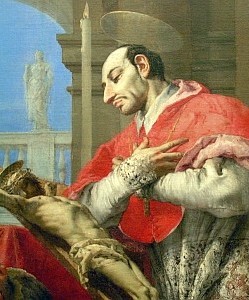
Saint Charles Borromeo
(by Giambattista Tiepolo)
St. Charles had so great a respect for the ecclesiastical habit, which he had worn since childhood, that he avoided even the smallest act of levity that was unbefitting his vocation. He led an ascetic life, arming himself for the tasks ahead with fervent prayer and devotions, severe fasts, mortifications and austerities. But above all things, and throughout his entire life, he was most careful to preserve his heart and soul from every stain of impurity which he abhorred as contrary to the angelic virtue required in ecclesiastical persons. His love of purity was such that he never let anyone see his arm, foot, or any other part of his body uncovered; nor did he speak to any woman, not even to pious relations, or any nun, without at least two people being present, and even then as briefly as possible. Keeping himself far from every stain, he could not bear to hear anyone utter a single impure word.
St. Charles went to confession every morning – before celebrating Mass, and instructed his priests to confess at least once a week. He had a great respect for the liturgy and insisted on scrupulous reverence and decorum not only in celebration of the Holy Sacrifice of the Mass but also in recitation of the Divine Office and in all religious rites and ceremonies. The habitual neglect of the Sacraments, gross abuses in religious practices and irreverence for holy places and things he encountered in Milan greatly grieved the archbishop. It was thanks to him that beauty, dignity and splendor were restored to liturgy, and abuses were suppressed with all severity.
The saint’s devotion and fervor for the glory of God quickly rubbed off on the Milanese, whose love and reverence for all holy things greatly increased. The previously deserted cathedral had people flocking to the services of the Church; their dedication to the worship of God rose as soon as they saw it worthily celebrated. To further draw their hearts to the love of God the saintly archbishop revived and encouraged devotions (including the ancient Forty Hours devotion), Eucharistic processions, adoration and pilgrimages (especially to the Holy Shroud of Turin and to Marian shrines).
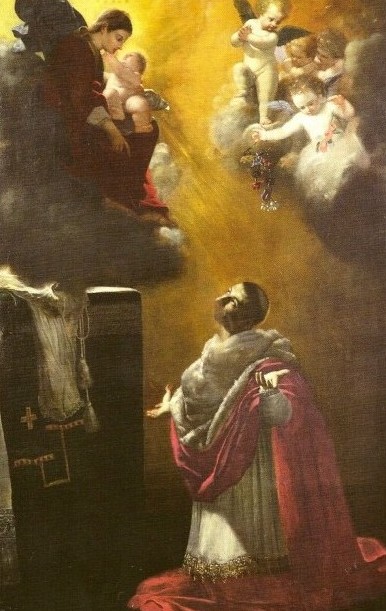
The Vision of St. Charles Borromeo
Proper education and training of priests and solid instruction in Catechism and Catholic doctrine for laity was a priority for St. Charles. He established many seminaries and colleges for the education of clergy, and founded the Confraternity of Christian Doctrine with schools teaching the Catechism to children (these were the first Sunday Schools; by time of his death there were 740 such schools in the archdiocese, with over 40,000 pupils). Also founded by the saint were the Oblates of St. Ambrose, a secular fraternity of priests who supported him in religious works wherever they were needed. Nor did he neglect to establish throughout his archdiocese schools for instruction of the poor, orphanages and hospitals.
St. Charles’ zeal and care for the souls of his charges eventually bore wonderful fruits and his became the model see not only in Italy but in all Catholic lands.
Pastoral visits
As archbishop he held six provincial councils and eleven diocesan synods, and traveled untiringly on pastoral visitations throughout his vast archdiocese, three times visiting every single parish. At the request of the popes he also made apostolic visitations to many other provinces. Even the most remote and inaccessible Alpine regions, completely abandoned by clergy, St. Charles deemed important enough to merit his time and effort. He would endure any privation and hardship (traveling on horseback and by foot, in heat and snow, lacking food and shelter) to win a soul for Christ.
Everywhere he went he found profound ignorance, rampant immorality, profanation, lack of reverence for the Sacraments and for priests, and almost no knowledge of God and His law. And so he wept and prayed, preached and catechized, admonished and instructed, drove out heresy, enacted reforms, replaced unworthy priests by pious and zealous ones, and restored dignity to divine service. As in Milan so in the poor mountain parishes, words of the holy man of God went straight to the sinners’ hearts. Countless souls destined for damnation were converted after hearing a single sermon, a few words of instruction, or a heartfelt plea from St. Charles.
In the Swiss valleys many were infected with the heresies of Zwingli, Calvin and Luther and the false doctrines of liberty of conscience, freedom to sin, life according to flesh and everything contrary to the law of God. The saint, deeply grieved at seeing so many on the road to perdition, succeeded in delivering countless souls from heresy and apostasy to God. His exhortations and sermons, and more so his personal holiness, worked miracles at bringing those deceived by false prophets back into the Church. The people, seeing his self-denial and austerities combined with such zeal for their salvation, highly esteemed the sanctity of the cardinal – this being quite the contrary of what heretical preachers had told them about prelates. Even in regions where all had lost the faith most people welcomed St. Charles with respect and joy, and were often well disposed for conversion at his bidding, for anywhere he went his reputation preceded him.
It was thanks to these extraordinary efforts and labors that the faith was preserved and heresy and debauchery defeated in the archdiocese of Milan and other territories under the influence of St. Charles Borromeo.
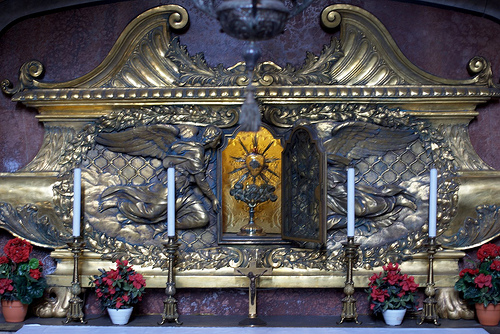
The incorrupt heart of St. Charles Borromeo
(Basilica dei Santi Ambrogio e Carlo al Corso, Rome)
Conflicts and assassination attempts
His necessary toughness in implementation of the Council of Trent and restoration of order and morals made the saint many enemies. For much of his life he suffered calumnies, false accusations and evil rumors propagated not just by heretics and incorrigible sinners but also clerics and religious who disliked his enforcement of strict ecclesiastical discipline. St. Charles paid no attention and simply fought on, working for God and the Church, with no care for himself, no thought for the judgement of men, nor fear of his powerful adversaries.
He never shrank from his duty to save souls and protect his flock from harm. When it brought him into conflicts with the secular powers he stood his ground and put all his trust in the Lord. His actions against highly placed laity, whose disorderly lives were causing public scandal, resulted in several efforts for his removal from office. (While episcopal jurisdiction in temporal things was still to a certain extent recognized – though not as commonly and extensively as in the medieval period – it wasn’t, in practice, respected in Milan when St. Charles became archbishop.)
When certain nobles living in public adultery proved impervious to his exhortations and attempts to win them to a better life, the saint, seeing the infinite harm caused by their example to the rest of his flock, ordered them to be imprisoned. (If public vice was allowed to pass unpunished, what hope was there for regeneration of the city and conversion of the people to honest, God-fearing lives?) The senate, seeing this as undue interference in secular matters, had the sheriff of the episcopal court seized, publicly beaten and banished from the city. After prayer and careful deliberation St. Charles declared several of the civil officials excommunicated. Both parties made formal complaints to Philip II; the king referred the matter to the Pope who upheld the archbishop.
In 1569 the canons of Santa Maria della Scala (a church under royal patronage), who lived lives unworthy of clergy, refused to accept the archbishop’s jurisdiction. When he tried to conduct a canonical visitation the canons insulted and attacked him; one of their armed supporters fired a shot, damaging the cross the saint was carrying. Throughout all this St. Charles stood brave and resigned, eyes fixed upon the crucifix, lips moving in silent prayer. Once again he had to resort to excommunication. The governor and senate sided with the canons and complained to both king and Pope, shamelessly accusing the holy prelate of treason, threatening to imprison and banish him. St. Pius V approved of the archbishop’s actions and expressed his astonishment that the people of Milan would not respect so good and holy a man whose only object and desire was to secure the salvation of the souls committed to his care. He further wrote (in a letter to the governor) that nothing could be more glorious to Charles Borromeo than to suffer banishment or death in the faithful discharge of his duty and in defense of the Church, and that the devil had stirred up this persecution to hinder the good effect of the archbishop’s zealous endeavors. Very shortly thereafter two of the chief actors in that outrage, including one who had shot at the cross, died sudden and miserable deaths.
Only a few months later St. Charles survived, quite miraculously, the most serious attempt on his life. Priors of the Humiliati – a decayed penitential order unwilling to submit to reform – plotted to have archbishop Borromeo murdered. A religious of the order, paid to carry out the hit, fired a shot at the saint – from a distance of four or five meters – as he was kneeling at the altar of his chapel. St. Charles, believing himself mortally wounded, calmly finished his prayers, signaling his staff to do likewise, and offered his life to God, thanking Him for allowing him to die for His Church.
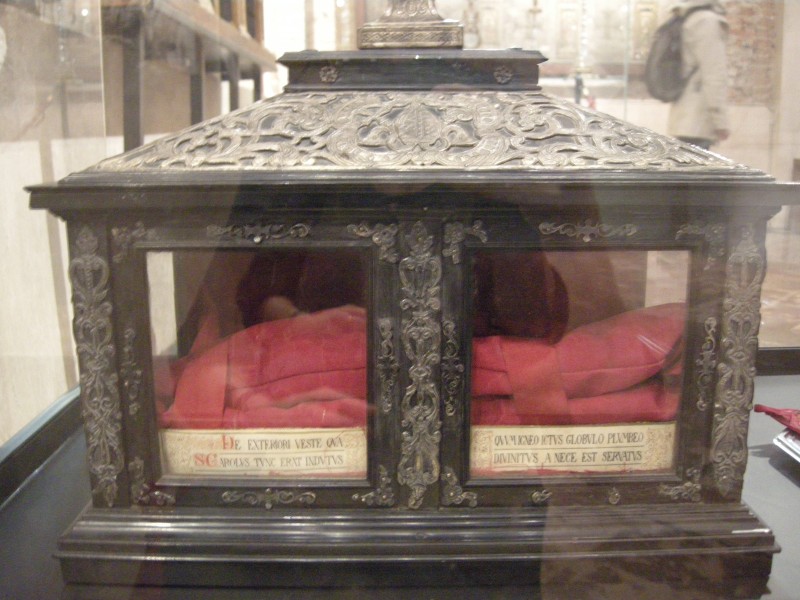
St. Charles’ vestments scorched by the bullet
(Basilica di Sant’ Ambrogio, Milan)
When the prayers were concluded the archbishop was found to be unharmed. The bullet had struck him on the spine, but instead of piercing him through and through it inexplicably fell down to his feet, leaving nothing but a slight swelling on the skin and the marks on his – pierced and scorched – vestments. (Whilst the bullet dared not shed the saint’s blood, some of the remaining shot penetrated a table of solid wood standing nearby, and made a hole in the wall.) The Lord wanted St. Charles to continue His labors on earth for 15 more years before allowing him to take his just reward in heaven.
The archbishop withdrew, for a few days, to a Carthusian monastery, and there made a new offer of his life to God and the Church. Meanwhile the news of his miraculous preservation turned the open hostility of his enemies into sympathy and admiration. Even the rebellious canons of La Scala humbled themselves and submitted, upon which the archbishop lifted their excommunication and ensured the culprits would be treated with leniency. Similarly, when his would-be assassin was captured, the saint begged the Pope to pardon him, but St. Pius V could not allow such injustice; the man was executed and the order of the Humiliati abolished.
It wasn’t long before St. Charles’ problems with Milan’s secular powers resumed. The new governor, whom the archbishop had considered a friend, soon began attacking him and infringing upon the rights of the Church. St. Charles sought advice of the Pope (Gregory XIII, St. Pius V having died in 1572) who instructed him to excommunicate the governor and all those who had aided him in rebellion against the Church’s authority. Following the excommunication the governor became an open enemy, interfering with the saint wherever he could. He hindered the meetings of Confraternities, sent armed men to take possession of the Borromeo family castle of Arona, and posted several companies of infantry and cavalry outside the archiepiscopal palace as though the archbishop was a state prisoner (which did not deter St. Charles who continued to go in and out as his duties required, without regard to the threat). At last king Philip II transferred the governor to Flanders where he soon became ill and, after two years of terrible suffering, died.
The archbishop’s battles with the civil government were not over, however; the next governor was just as determined to bring down ecclesiastical authority as his predecessor. Although Pope Gregory XIII had backed St. Charles, the governor was not deterred and continued acting – and encouraging the people to act – against his ordinances. To ensure proper observance of Lent, St. Charles forbade any balls, festivities and tournaments to take place during the forty days. Rebelling against the order, his enemies organized a public tournament the first Sunday of Lent, in front of the cathedral. In response the archbishop excommunicated all those who had participated in that grotesque act of impiety. Shortly thereafter the wretched governor became gravely ill and died.
Humility and charity
St. Charles was not only famous for his strictness but also his great humility and charity. He would not let any praise or flattery be directed at himself, and never spoke of his own actions unless to ask for advice or to condemn his deficiencies. He was grateful to those who would point out any faults they might see in him, and often implored people that they may do him this favor. No matter how he was treated, he always considered it better than he deserved. Whenever he encountered any obstacles in doing all the good he wished, instead of blaming the parties responsible for the troubles, he put it down to his own sins and shortcomings. Always displeased when hearing of virtues being ascribed to him, he tried to conceal them as much as possible to dispel the idea that he was a saint.
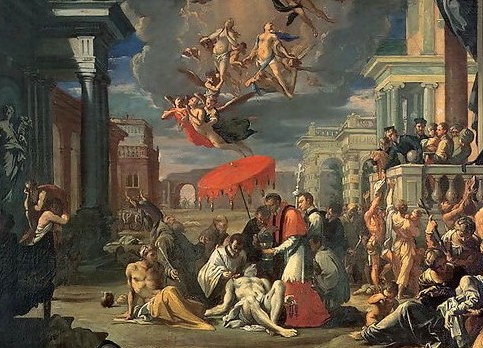
St. Charles Borromeo Administering the Sacrament to Plague Victims (by S.Caula)
St. Charles’ entire life was a testimony of boundless charity and care of others; examples of his selfless assistance to the people of his diocese would fill volumes. During the plague and famine of 1576 he spent all of his money, and even incurred great debts, to daily feed 60,000 people. When the plague broke out many people – including the governor and nobles – fled Milan. The saint not only stayed but dedicated himself entirely to the poor wretches – distributing food, clothes and alms, visiting the sick in their homes, and working at the hospital where the plague-stricken were isolated and left to die. Their archbishop was the only one who would not forsake them, administering the last Sacraments and providing much needed spiritual consolation in their final hours. The clergy of Milan refused to help him in such work, so he sent for (comparatively fearless) priests and laymen from the Swiss valleys. Finally, shamed by St. Charles’ heroism, many Milanese – laymen and clergy – offered their aid.
Sin being the cause of scourges, the saint, at the foot of the altar, made a voluntary sacrifice of himself, offering his life – if God would accept it – in atonement for the iniquities of his people. He redoubled on his already severe bodily discipline, fasts and mortifications, and urged people to do penance. In penitential processions he walked with a rope around his neck, his feet bare and bleeding, a large crucifix (along with a relic of the Holy Nail of the Passion of Our Lord) in his hand, endeavoring to turn away the just anger of God.
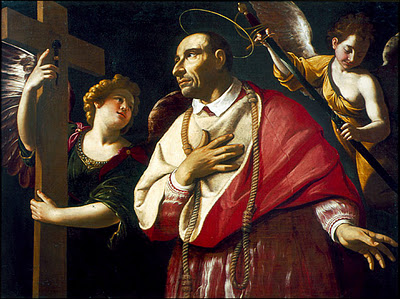
St. Charles Borromeo and Two Angels
(by A. Grammatica)
Altars were erected in the streets throughout the city so that all people, quarantined in their homes, could assist at daily Mass from their windows. Priests went from house to house, hearing confessions on the doorstep (the penitents kneeling inside behind the door), and on Sundays parish priests went round with the Blessed Sacrament, giving Holy Communion to people on their doorsteps. Prayers, psalms and hymns were sung seven times a day (after the manner of the canonical hours), and all the inhabitants attended at their windows, making the responses on their knees. St. Charles thus united the whole city to offer praise to God in one voice.
All for the glory of God
It is well to remember that, while practicing personal poverty, humility, and contempt for earthly things, the saint at the same time maintained the splendor of his ecclesiastical dignity. He understood the obligation of giving due honor to his office of archbishop and cardinal – for the glory of God and edification of his people. When he was speaking in his own person, he placed himself below all, but when he spoke as cardinal he justly deemed himself above every other dignity inferior to his own. In the same manner, he required due honor and respect to be paid to the office of bishop, which he deemed as much above any worldly dignity as the spiritual is above the temporal. [He would never tolerate those who, in a outward show of (false) humility and poverty, take away the respect and honor due to God and the Church… which is precisely what the wretched prelates of our times are wont to do.]
St. Charles, as his rank required, dressed with great decorum and solemnity. Yet underneath the external grandeur of a cardinal he always wore a rough hair shirt and so, unknown to others, practiced penance for his sins and those of his people. Many times when visiting churches in pilgrimage he wore shoes without any soles in order to have only the pain but not the praise of men.
Once St. Charles, sitting in his carriage, was approached and greeted by a friar. The friar, who was walking on foot, made a remark about the benefits of a cardinal’s office with splendid robes, magnificent carriages, and such. The saint responded by inviting him to journey in his carriage. Yet barely had the friar taken a seat he started crying out in pain; placed beneath the beautiful cushions of the benches were iron nails the holy prelate used to mortify himself. The friar, unable to tolerate the pain, begged to be let out, gladly returning to the comfort of traveling by foot.
The beauty and grandeur were there to glorify God before the people, and to make them conscious of the importance of Divine things. The mortification was directed and offered to the Lord and therefore best done in secret – lest one might become tempted to seek admiration and praise of others. [Is the modern attitude not rather the opposite? A mask of outward humility covering souls full of pride…]
St. Charles was also responsible for magnificent restoration and rich adornment of many churches in Milan, Rome and elsewhere; the seminaries, schools, convents, archiepiscopal palace and other ecclesiastical structures he built were equally admirable for their beauty. From the houses of God he removed everything that was unbecoming, such as profane statues and paintings, military flags, memorials of nobility, etc. This he did throughout his archdiocese despite strong opposition, for his sole regard was for God’s honor rather than gratification of human inclinations. He enriched churches with both material and spiritual treasures. A priest, amazed at seeing the transformation carried out by the archbishop, left this testimony: “His church fills every one with astonishment, and seems like the palace of Solomon, and the temple of Jerusalem.”
When it came to altars, sacred vessels and anything else required for Holy Mass and the other offices, St. Charles spared no expense in order that everything might correspond with the majesty and glory of God. He was of one mind with all the saints in that it is our duty to give God only the best, the most splendid of everything. [This is another message entirely lost (on purpose, one must say) on the modernist destroyers – clergy and laity alike – who strip churches, altars and tabernacles of everything that was, in beauty and magnificence, duly glorifying God, and build barren, ugly-as-sin, soul- and faith-destroying edifices befitting their blasphemous cult of man.]
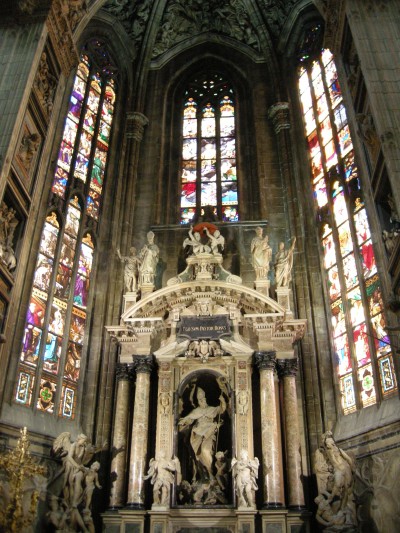
Duomo, Milan
St. Charles understood the importance of the majesty and exactness of ritual, and insisted on observance of proper ceremonies even to the smallest particulars, not allowing any deviation. He considered nothing unimportant that appertained to the worship of God, though it might seem so to ordinary people. Detailed rules were laid down for the clergy in saying the Divine Office, to increase devotion and attention paid to its recitation.
The saint insisted on respect and veneration for holy places, to which testify his many decrees regulating behavior in churches. He forbade chattering and walking about, made men sit separately from women, required women to veil their heads and men to wear cloaks, among other things. All were expected to assist at the Holy Sacrifice of the Mass with utmost reverence, piety and devotion, and all public and scandalous sinners were excluded as unworthy to be present. Seculars, of course, were not allowed to enter the choir or approach the altars – and no one, not even the king, was exempt from these rules.
The archbishop also restored proper observance of Advent and Lent, of vigils and ember days, into which many abuses had crept. He was especially careful to ensure veneration for the Blessed Sacrament and decreed that it be reverently kept in all churches upon the high altar, in tabernacles of the greatest possible beauty and splendor, with a lamp constantly burning. On no occasion could the Blessed Sacrament be removed to any other and inferior altar, for it would be unbecoming of His Divine Majesty.
Putting all of this into practice cost the saint much difficulty and grief amid great opposition, but he never relented and in the end saw an almost miraculous transformation of his archdiocese. What had previously been known for its abuses, corruption, scandal and sin became a spiritual garden or, in the words of one cardinal, “heavenly Jerusalem”.
Spiritual life
St. Charles was immersed in the world, from his birth to his death, and yet no man was less of the world.
While men of the world try to avoid suffering and become attached to every comfort, Charles Borromeo, on the contrary, avoided every comfort and sought for greater suffering and bodily affliction. He renounced any sentiments of self-love and became perfectly disengaged from all earthly things and desires, to be absorbed only in God. The passions that so often blind and influence even the best of men had no place in his heart. Wealth, which is a source of danger to most, in his hands turned into an instrument to advance the glory of God, and an incentive for even greater watchfulness in working out his salvation. God, in His mercy, amidst all the prosperity let Charles see the worthlessness and vanity of earthly things, fixing his mind on the true riches of heaven.
In spite of his important roles and incredible activity and labors, he managed to lived the life of a contemplative. Even among the saints it is exceedingly rare to find one who so perfectly mastered both the active and the contemplative. St. Charles’s life was indeed one long act of prayer, mortification and self-denial.
Prayer was his nourishment and delight; in prayer he was immersed many hours of the day and night. “Souls,” he used to say, “have to be gained on the knees.” On any occasion of importance for the Church or public welfare, or when visiting holy places and relics of saints, he would remain all night in contemplation, denying himself even the few hours of bodily rest. He was wont to pass whole nights in prayer in the church of St. Ambrose in Milan – before the relics of the saint, and in the Catacombs of Rome. When on the road he spent all the time completely absorbed in prayer. Even while occupied with business he was in the presence of God, mind always raised to heaven.
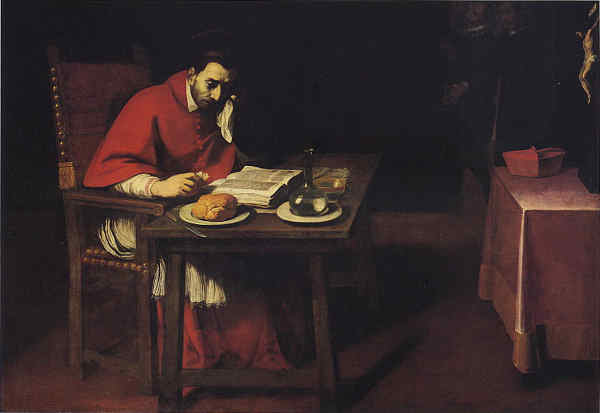
The Fasting of St. Charles (by Daniele Crespi)
Aside of devotion to prayer Cardinal Borromeo’s life was defined by strict discipline and great private and public penances. He chastised his body with daily fasts (in the later years on bread and water, except on Sundays and feast-days), wore a rough hair-shirt, and scourged himself mercilessly. He patiently endured heat and cold, even during his arduous journeys, never warming himself at the fire in the winter, nor wearing gloves and furs. Although by nature much inclined to sleep, he allowed himself very little rest, and that on a bed of straw (this being perhaps his greatest struggle between body and spirit).
All of this helped mortify his will and sanctify his soul, keeping him detached from the temptations that overwhelm lesser men. By this strictness and austerity of life he also strove to make up for the honors and dignities which were forced upon him. (It is no coincidence that almost all great saints have chosen the path of constant mortification. And while many – especially today! – consider this excessive, it’s well to note that as severe as the penances were they never prevented St. Charles from doing his labors in the service of God.)
No matter how exhausted, he never neglected any of his religious duties, not even in grave sickness. The Divine Office he always recited kneeling, as well as the Little Office of Blessed Virgin Mary and the rosary. Likewise he read the Holy Scriptures on his knees. When he heard the Angelus ring he knelt down wherever he might be, even in the mud. Many times during mental prayer or while saying the Office he went into ecstasies.
A rule St. Charles inviolably observed was to go to confession every morning – before saying Mass, and to make a spiritual retreat at a monastery twice a year, where he always made a general confession. Out of respect and devotion to the Holy Sacrifice he always kept rigorous silence (unless very important business intervened) from the evening prayer and meditation until the next day after Mass and thanksgiving. It was, he used to say, unbecoming a priest to apply his mind to any temporal business before that great duty.
As already mentioned, the saint was indignant upon seeing any irreverence, profanation or lack of honor for God and all things divine. It is then no surprise that he discharged all religious duties not only with the greatest attention but also with the most perfect ceremonial, even in the mountain villages and among the simplest people – because he had no regard to place or persons but only to the majesty of God whom he was serving. He would rather omit a function than perform it with the least defect or imperfection.
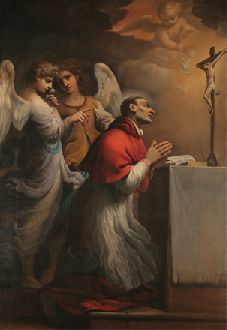
St. Charles in prayer
Cardinal Borromeo had an extraordinary devotion to the Blessed Virgin; he put all his colleges under her patronage and recommended everyone – even soldiers – to daily recite her Office and rosary. He was devoted to St. Ambrose whom he took as his patron and model of holiness and whose picture he always kept near; and to the Milanese martyrs Sts. Gervasius and Protasius. He also carried on him a small picture of the English bishop and saint John Fisher, martyred by Henry VIII. Great was his veneration of holy relics. He undertook long journeys to visit relics of saints and martyrs, passing whole nights in prayer before them. A relic of the True Cross was one he always carried on his body.
The Passion of Christ was a constant object of St. Charles’ devotions and meditations. He had a great reverence for all its sacred instruments, including the relics of the Holy Nail and especially the Holy Shroud of Turin to which he made several pilgrimages. At Rome he frequently spent long hours (and sometimes whole nights) on his knees in the chapel of the holy pillar of Flagellation in the basilica of St. Praxedes, as well as in other places of devotion. Whenever able he visited sacred places, churches, the stations of the Cross – and encouraged others to do likewise.
St. Charles’ example of great personal holiness and virtuous living was edifying to everyone around him. He would spare no effort to try and save souls over whom he had been appointed to watch, fervently working for their conversion and sanctification. But it was above all his personal example and sanctity that converted countless obdurate sinners as well as Protestant heretics.
To a layman asking for instructions for gaining heaven, the saint gave this answer: “Whoever desires to make progress in the way that leads to God must always endeavor to serve God with the same fervor as if he were making a fresh beginning every day; he must always walk in the presence of God, and make Him the end of all his actions.”
No human respect
His heart and soul turned solely to God, and never seeking anything but His greater glory, St. Charles feared no man’s censure and coveted no man’s praise. Unlike the feeble prelates and men of our day, he never hesitated to sacrifice his personal popularity, welfare and even safety for the good of the Church and the Faith. He had a sincere contempt for the opinion and false maxims of the world. His fear of God and hatred of sin made him so upright and uncompromising that neither respect for princes, nor favor of friends and relations, nor promises or threats had any influence over him.
He held truth and sincerity in so great esteem that he could not endure flatterers – who deceive with their words – and would not have anything to do with such persons, considering them a cause of many evils. Candor and sincerity are required of those who profess to be Catholics, and cardinal Borromeo was always sincere with others, regardless of their rank – Pontiffs and princes included, never allowing himself to be affected by any human respect. He never failed to admonish all who needed it, and was even more ready to perform this act of charity for princes and prelates, knowing they had few or none to tell them the truth.
He met opposition with unalterable firmness and resolutely enforced observance of his decrees. No one would ever be able to divert him from the course or make him change his mind when he knew to be doing the right thing for the glory of God and the good of souls. The saint was very disapproving when he saw prelates yielding, for no sufficiently grave reason, to laity and secular powers. His readiness to offer up his life in defense of the rights of God and of His Church gave him the fortitude to act regardless of danger.
Once criticism was directed at the saint for his nine day long pilgrimage (to the Holy Shroud) done solely by foot. Many – including Pope Gregory XIII – censured him, for they saw it unfitting of a prelate to journey in such manner through the country. Cardinal Borromeo, not in the least disturbed, wrote, in a letter to Rome: “I wish you to understand that on such occasions the principal thing is to do what one considers right and to be perfectly indifferent to the world’s opinions.”
Carrying the cross with joy and total trust in God
“All that will live godly in Christ Jesus, shall suffer persecution.” (2 Tim. 3:12).
“The servant is not greater than his master. If they have persecuted me, they will also persecute you.” (John 15:20)
St. Charles Borromeo, one of God’s greatest and most blameless saints, had abuse heaped upon him during much of his life, not only by worldly men but also religious. The fact that he always stood up for righteousness and truth and was an incorruptible defender of Divine law and justice brought him the hostility of powerful men, the distrust of the nobility, clergy, and people, and eventually drew upon him the deadly hatred of the wicked, so that his very life was sought. Placing all his trust in God, he held out against all of this with invincible courage.
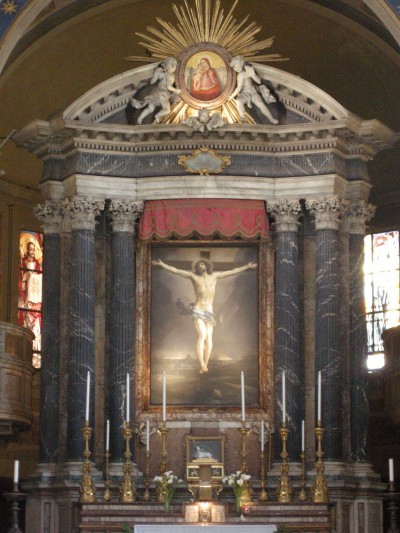
Crucifixion by Guido Reni
(San Lorenzo in Lucina church, Rome)
Malicious men always took exception at the saint’s exemplary spiritual life, calling him a hypocrite and impostor. He was insulted, calumniated and slandered, yet bore all patiently for the love of God, remembering how Jesus endured everything that was sent Him. He accepted the sufferings as mortifications that would further purify his soul and detach him more perfectly from the world. To be scoffed at, insulted, and abandoned was an honor, for it allowed him to bear what Christ bore, thus bringing him even closer to the Lord. What to others is a cross of pain to St. Charles was a crown of glory. The more bitter the cup became, the more he gave thanks to God for being allowed to suffer with his Savior.
St. Charles said that the whole of the Catholic faith was summed up in the love for the cross. And so he was always eager to suffer more for our Lord, and to offer his life for the love of Him. The cardinal’s vestments were by their color a constant reminder to him that he might be called upon to suffer death for Christ’s sake: “I am clothed in red in token that I am ready to shed my blood in the service of the Church.” As his fellow cardinals later testified, “martyrdom stopped short of him, not he of martyrdom”.
St. Charles’ confidence in God was so great that he had no doubt whatsoever that He would take care of him. He knew that as long as he conformed to God’s Will he had nothing to fear, and thus was not daunted by any threats and attacks. Because the only motive in all his undertakings had been to promote the glory of God and to defend the rights of His Church, his good conscience and total trust in Divine Providence made him invincible.
The saint used to say that he who serves God with a pure intention, casting aside all self-interest and seeking only His glory, may always hope for success, especially when, according to human judgement, there seems to be only failure. Therefore he exhorted everyone to have complete confidence in God, who never abandons those who place their trust in Him. St. Charles’ success in so many undertakings which to human judgement seemed impossible attests to that truth.
Against heresies
It has always been the case that in times of grave danger to the Faith and to Holy Mother Church God raised great of saints to defend the Truth. St. Athanasius, a 4th century titan of the orthodoxy (followed by a few others – St. Hilary, St. Ambrose, St. Basil the Great, St. Gregory Nazianzen) near single-handedly saved the true Faith when almost all had embraced the Arian heresy. St. Dominic fought against the heresy of the Albigensians (Cathars). And the 16th century was the time of the glorious saints of the Counter-Reformation: St. Pius V, St. Charles Borromeo, St. Robert Bellarmine, St. Ignatius of Loyola, St. Francis de Sales, St. Peter Canisius, St. Teresa of Avila, and several others.
The Church at that time was in a deplorable state. The faith had grown dormant and almost extinct in many, discipline and morals had been dethroned in both the clergy and the flock. Luther, who started his revolt 21 years before Charles Borromeo was born, brought, with his followers, devastation and ruin to millions of souls, perverting the knowledge of the truth and further corrupting morals.
Defense of the faith against the heresies that threaten destruction of souls is a mission and duty of the Church – a fact the great saints and popes were always keenly aware of.
St. Charles spared no effort to preserve the Church from the least taint of error and to suppress and extirpate heresy. “It is a certain and well-recognized fact that by no other crime is God more gravely offended, by none provoked to greater wrath, than by the vice of heresy, and that nothing contributes more to the ruin of provinces and kingdoms than this frightful pest.” – Cardinal Borromeo
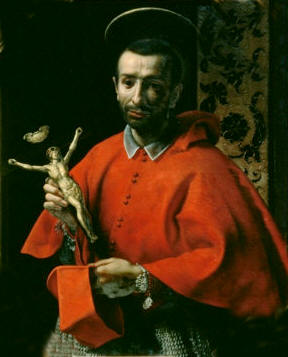
St. Charles Borromeo Archbishop of Milan (by Carlo Dolci)
The saint left nothing undone to check the spread of heresy in Europe. In accordance with the decrees of the Council of Trent he ordered all libraries to be examined and every doubtful book to be cast out, forbade the printing of books suspected of heresy or contrary to good morals, and directed that schoolmasters should be men of good repute and should pay more attention to teaching of faith and doctrine instead of mere book-learning. When any heretic had occasion to enter his diocese he required notice to be given of it, lest Catholics should be perverted. Heretics were not allowed to enter churches except during sermons, and were forbidden to display any outward signs of heresy (for instance eating meat on Fridays, etc) so as not to cause public scandal and dishonor God among the people.
St. Charles also required the profession of faith and obedience to the Supreme Pontiff from all clergy and religious, from preachers and confessors coming from other provinces, as well as from physicians, surgeons, schoolmasters, teachers, lawyers, booksellers and printers of books. Any who were not good Catholics were prevented from holding such offices, in order that danger to souls might be avoided.
He knew it was bishops’ duty to purge their dioceses of the evil of heresy. In the second Provincial Council of Milan he addressed the bishops and priests with these words:
“Fathers, this is our duty, and our office, placed as we are in the exalted seat of episcopal dignity, to look out for dangers as from a watch-tower, and to repel them when they threaten those who are resting under our charge and care. As parents we ought to have a fatherly oversight of our sons; as pastors never to take our eyes off the sheep which Jesus Christ has delivered by His holy death from the mouth of hell; and if any are being corrupted by the impurity of vice, to heal them with the sharpness of salt; if any be wandering in moral darkness, we ought to hold the light before them…”
He continued: “But if we act otherwise, at the fearful judgment of God, when we shall give an account of the souls entrusted to our charge and care, we shall hear their accusing cries, and the anger of the Judge sharply upbraiding us, and saying: ‘If you were watchmen, why were you blind? If pastors, why did you let the flock committed to you wander? If the salt of the earth, how did you lose its savor? If you were the light, why did you not shine to them that sat in darkness and the shadow of death? If apostles, why did you not use apostolic power, why did you do all things for the eyes of men? If you were the mouth of the Lord, why were you dumb? If you knew yourselves unequal to this burden, why so ambitious? If equal to it, why so careless and neglectful?”
“Hence the Bishop must, above all things, persevere in this eternal solicitude and continuous vigilance, not only to prevent the most pestilent disease of heresy from penetrating among the flock committed to him, but even to remove the faintest suspicion of it from them. And if it should happen to penetrate, which may the Lord Christ in His pitiful mercy forbid!, then he must strive at once by all means in his power to have it driven out immediately, and he must have those who are infected or under suspicion of being infected with the pestilence treated according to the pontifical canons and sanctions.”
[O how much we, who live in an age when the truth has been all but lost and falsehood and perversion reign supreme, need holy, fearless and uncompromising prelates in the mold of St. Charles Borromeo… and pontiffs like St. Pius V!]
End of life
Despite his arduous work, fatiguing travels, and a rule of life so strict it was almost not in human power to fulfil it, St. Charles never showed any signs of weariness. It was thought something miraculous that the cardinal, whose health was always delicate, could bear so much, especially considered how little rest he took and how great his austerities and mortifications were. His apostolic zeal and untiring care for the beloved flock made all labor and hardship easy to him.
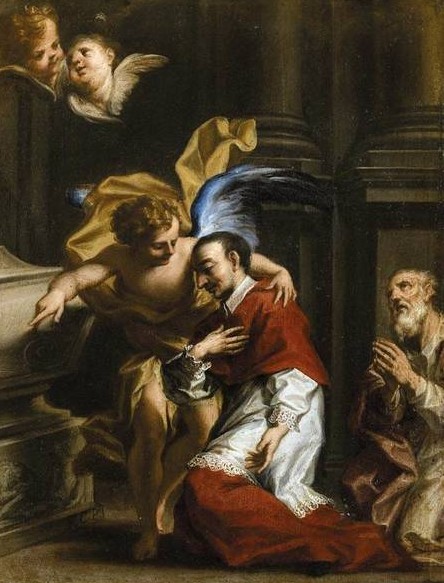
St. Charles Borromeo Tended by an Angel
(by Francesco Caccianiga)
It was November 3, 1584 when the Lord at last granted the holy prelate what he had been yearning for, and took him to his just reward. St. Charles was only 46 when he died, spent from his fervent labors for the glory of God. Even in his last days, consumed with fever and pain, he would not give up his vigils, fast and austerities. He desired to leave this world in sackcloth and ashes and so, as his final hour was approaching, the priests of his household dressed him in penitential garb and sprinkled him with ashes. In this manner – a fitting conclusion of a life of continual penance – St. Charles expired. His last words were “Ecce venio” (Behold, I come).
Never before had Milan seen such grief and sorrow as overtook the city at his passing, and the loss was equally lamented in Rome and by Catholics throughout the world. He who had been a burning light shining before the whole Church would now have an even greater lustre and glory in heaven. (In the days after his death the saint appeared, clothed in great light and glory, to several priests, including his spiritual director Father Adorno to whom he foretold he’d soon follow him to heaven – which came true a few months later.)
In his life Cardinal Borromeo held a remarkable position of influence in Europe – his opinion and advice were sought by all the Popes under whom he lived as well as by many European sovereigns (whose high opinion and reverence for him is attested by the 31 volumes of letters addressed to the saint by eminent persons from all parts of the continent, including Protestant princes). He was admired by his fellow cardinals, priests and laity as a great model of holiness, virtue and zeal. Cardinal Baronius considered him “a second Ambrose, whose early death, lamented by all good men, inflicted great loss on the Church”.
Cardinal Sirleto wrote in his eulogy:
“Charles Borromeo, imprisoned in the body while his soul was in heaven, seemed to have nothing of the flesh in him save the outward appearance. In appearance he was a man, by grace an angel. He was a model of Christian piety, a mirror of the office of Bishop and Cardinal, a strong defense against the wicked.
He was a shining ornament of the Church of God. He was in life and holiness as salt, as a light by his learning and preaching, a city of defense on the hill of Sion, a burning lamp of the Gospel. He had the faith of a martyr, for he desired but had not the lot of martyrdom. In wisdom a Doctor of the Church, in his life a Confessor, he ruled with the discipline of a Pastor.
In innocence he was like Abel; in uprightness as Noe; in faith as Abraham; an Isaac in obedience; a Jacob in labor; a Joseph in chastity; a Moses in meekness; a David in humility; in zeal, Elias; a workman that needed not to be ashamed, rightly handling the word of truth, undertaking nothing save for the glory of God; with soul so established in Him that he never could be overcome; in one word, a treasure-house and home of every spiritual gift.”
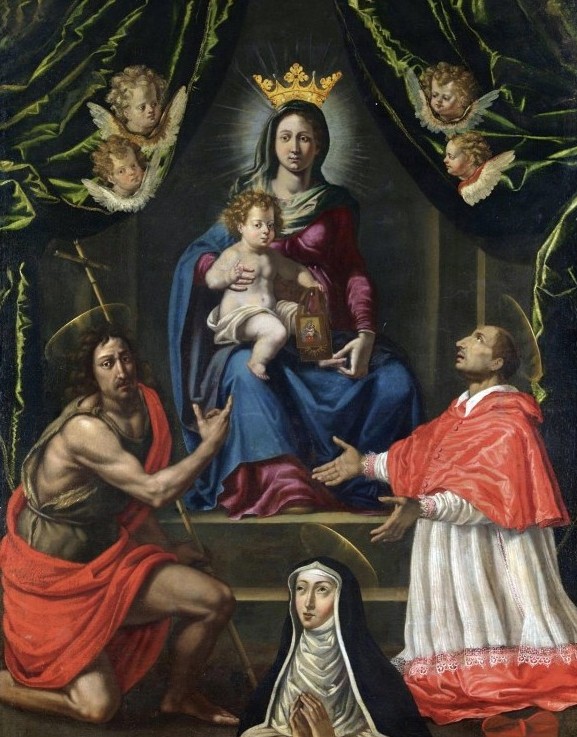
Madonna and Child Enthroned with St. John the Baptist, St. Charles Borromeo and St. Mary Madgalene de Pazzi (by F. Curradi)
Gabriel Paleotto, Cardinal Archbishop of Bologna, called the saint “a new kind of relic in the body of a living man, a tabernacle containing a divine and holy spirit. A pattern of ancient discipline, a mirror of innocence, dwelling-place of all virtues, a model of episcopal dignity; setting a fresh example day by day of watchfulness, of pastoral solicitude, of a desire for heavenly things and a distaste for those of earth, of continual labor, of unusual abstinence, and of invincible constancy. He was an illustrious Prelate, shining like a sun, a most holy Cardinal, a pattern for Bishops of our time.”
Antonio Seneca, bishop of Anagni, who was during eight years a member of St. Charles’ household:
“Charles did perpetual violence to nature, most vigilant as he was and unwearied in watching over his senses, a model of holy living, a blameless pattern of evangelical life, a bright mirror of spirituality purified form passion and appetite. He joined prudence to simplicity, justice to mercy, a great heart to humility, severity to meekness, gravity to modesty, and discretion to zeal. He did not scatter or fleece the flock, but was a true shepherd. In the defense of his people and of the liberties of the Church he was like a stronghold, a pillar of iron, a wall of brass. Vigilant in rooting out vice, benevolent in correction, just in judgement, loving in punishment, patient of human weakness, quick to avenge disobedience, his justice was united with kindness, his severity with gentleness and peace. He was a diligent guardian of wholesome discipline both in priests and people.”
Miracles and canonization
Charles Borromeo is one of those saints whose holiness was widely acknowledged even during life. His reputation for virtue and sanctity was such that wherever he was passing people flocked to him in the thousands, kneeling on the roads to ask for his blessing. Cities were instantly transformed during his visits, the inhabitants willingly giving up their worldly amusements in order to attend to piety and devotion in the presence of the saintly prelate; churches and cathedrals were overflowing as everyone desired to hear his Mass and sermon and receive Holy Communion from his hands. (St. Charles used to preach and administer the Sacraments wherever he went, even beyond his province. Great multitudes received Holy Communion from him, especially on great festivals when he was occupied in this duty from early morning till vespers; on one occasion he gave Communion to as many as eleven thousand people.)
People’s joy at his presence was as overwhelming in cities as in the poorest and most remote mountain villages. They would always try to touch his vestments or secretly touch their rosaries to them – such was his reputation for sanctity. Objects belonging to him or touched by him were sought-after and revered by the faithful as relics even while the saint was still alive. The rooms in which he rested at night during his visitations were reverently kept, by the house owners, from profane use and converted to oratories or else deemed sacred after the cardinal had honored them by his presence. (Even many Protestant heretics were so convinced of St. Charles’ sanctity that they too carefully preserved, as precious treasures, objects that were used by or came into contact with him.)
The universal belief in the sanctity of the great prelate only increased after his death. Popular devotion and confidence in his intercession arose almost immediately; the people of Milan, on their own accord, kept the day of his death as a feast of obligation, adorned houses with his pictures and erected altars in his honor in different parts of the city. The veneration was strengthened by the numerous miracles and graces obtained through St. Charles’ intercession. Not only Milan but many other Italian and European cities hold records of many attested cases of miracles. More than a thousand miracles were evidenced to have been worked at the saint’s burial alone. The astonishing number of ex-votos in the Duomo of Milan testifies to the copious graces received by the holy cardinal’s intercession – just of the silver ex-votos there are more than ten thousand!
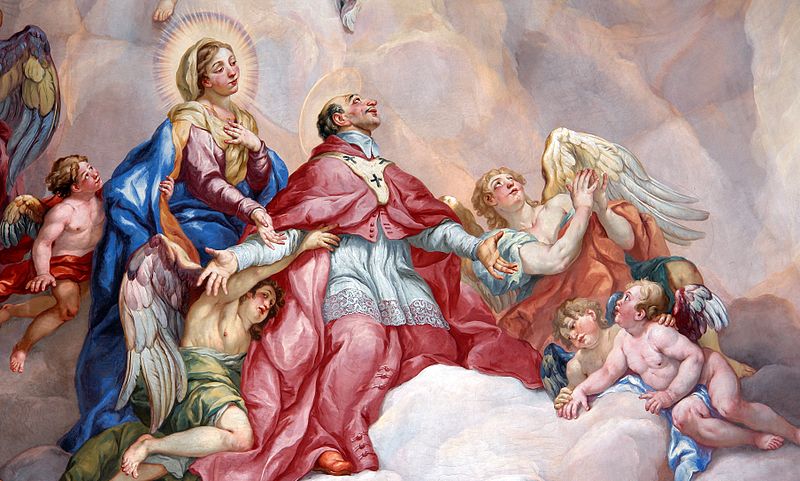
The Intercession of Charles Borromeo supported by the Virgin Mary,
by J.M.Rottmayr (Karlskirche, Vienna)
God was pleased to work miracles through St. Charles even in his lifetime, including several hundred astonishing and instant cures of simple people as well as clergy and nobility, many duly certified by physicians and under oath. Such was his fame of curing the dying by his blessing that he had to be careful about visiting the sick, for everyone wanted his blessing in the hope of being healed. During his visitations to the Swiss valleys, on at least two occasions the Lord, hearing St. Charles’ prayer, miraculously saved his companions who were at the point of drowning in a river or plunging to their deaths in the mountains. Numerous people possessed by evil spirits were freed after a benediction of the saintly archbishop.
Countless more prodigies occurred after his death, as were also wrought by his relics. The sick and disabled who paid a visit to St. Charles’ body (exposed for several days after his death) and touched it, in a belief of obtaining a cure by the merits of the great servant of God, were instantly healed of their maladies. Thousands of miracles, many recorded under oath for the canonization process, happened in the years following cardinal Borromeo’s entry to heaven. Great numbers of incurably ill were instantly restored to health, including those suffering from birth defects and paralytics who regained the use of their lame limbs upon praying at the saint’s tomb or in front of his pictures. In some cases St. Charles appeared, shining like the sun, to the sick and dying, in their sleep, to tell them they had been healed – and indeed upon awaking they found themselves restored to perfect health.
A boy born to an apothecary and his wife, who had already lost two small children to the same malady their youngest was born with, died on the sixth day of his life, in the presence of his parents, a nurse and matron; while the father went out to arrange for his funeral he implored St. Charles, to whom he was very devout, for help, and the dead child was not only restored to life with no sign of his illness but grew far stronger and more robust than common for his age. Another astonishing miracle involved giving sight to a boy born blind – without eyes in his sockets. The mother, devoted to St. Charles, named the newborn after him; on the 25th day after the child’s birth, while the mother was praying for his intercession, her daughter saw the saint, clad in his pontifical robes, appear in the air to give the boy his blessing; turning immediately to little Charles mother and daughter saw, to their astonishment, that he now had two perfectly formed and sound eyes.
There were also other types of prodigies, such as the saving of a ship about to go down in a storm; or the case when the saint appeared to a laborer who was taking his mid-day repose in a church, warning him to leave for the building was about to fall – the man fled in terror and, relating the vision to some people he met outside, was met with disbelief, only for them to see the church, apparently sound and strong, crumble to the earth in that very moment. In another documented case a boy fell into the river and, about to drown, called upon the saint for help; St. Charles took him in his arms and held him above the waters for a quarter of an hour until a boatman came to help, taking the child from his arms (a great multitude saw this marvel, though the saint himself was only visible to the boy).
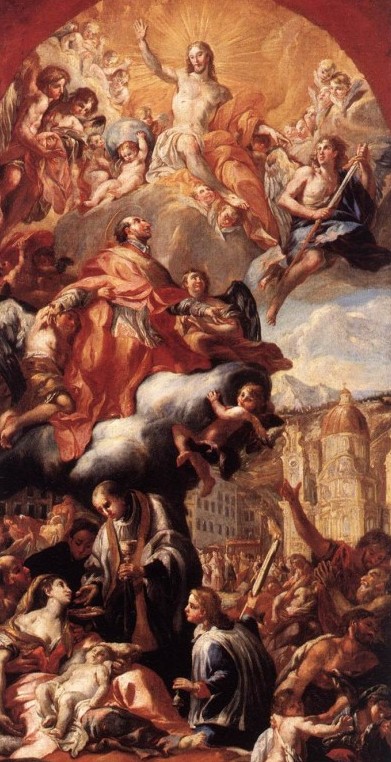
Apotheosis of St. Charles Borromeo
(by J.M. Rottmayr)
Such miracles were not limited to Italy but were also recorded in other parts of Christendom, wherever people prayed for St. Charles’ intercession. The beneficiaries of miraculous cures included many members of nobility and even royalty, most notably in Poland. Relics of the saint were also held in great veneration by kings and commoners alike. The king of Spain preserved, with the greatest reverence and devotion, a small portion of the cardinal’s hair-shirt; his queen kept as a most precious treasure his chasuble. The Duke of Savoy was presented with the rochet in which St. Charles was buried and, in order to give it an honorable place, had it put in the same repository over the high altar in which the Holy Shroud was preserved. The Grand-Duke of Tuscany considered the pontifical glove of the saint he was presented with to be of greater value than any province of his states. The Archduke Maximilian of Austria held in similar reverence a small portion of one of the albs used by St. Charles. Pope Paul V preserved with great devotion part of the alb in which the saint was buried. Cardinal Baronius (whose own canonization cause was reopened a few years ago), upon receiving the stole that had belonged to St. Charles, would not even touch it, but struck his breast as unworthy even to hold so precious a relic in his hands. God was pleased to work miracles by His servant’s relics; mere contact with the things St. Charles had used was enough to drive away disease and infirmity. His shoes, also kept by cardinal Baronius, were used to successfully exorcise the possessed.
Spiritual graces obtained by the merits of the saint were even more abundant. Through his intercession countless obstinate sinners were converted; people who had lived depraved lives suddenly repented, became exceedingly devout and spent the rest of their days in penance for their past sins. St. Charles, in heaven, has continued to work for salvation of souls as he did while upon earth.
Charles Borromeo was beatified by Pope Paul V in 1602 and canonized on November 1, 1610. His feast day is celebrated on November 4.
A model of a prelate – especially for our times!
It is astonishing how much St. Charles accomplished in his short life, in a mere 24 years of governing the Church. He entrusted himself completely to God and looked to Him and His assistance for all strength and virtue, exclaiming with the Apostle: “I can do all things in Him who strengtheneth me” (Phil. 4:13). The holiness of his life and perfect conformity to Divine Will made St. Charles pleasing to the Lord and worthy of His aid.
God raised this great saint to make him a champion of the true faith, defender of the rights of Holy Mother Church, and reformer of the evils that had crept in during the sensuous Renaissance period. His was an age of open licentiousness and immorality. The truths of faith have, in many places, been ignored or entirely forgotten. St. Charles, burning with holy zeal and love for God, had the necessary fortitude, coupled with prudence, to take on and root out the ills that had permeated both civil society and religious life. Feared for his severity and loved for his kindness, he succeeded – by instruction, admonition, and personal example of holiness – in changing men’s hearts and bringing them back to God. A teacher of the faithful, scourge of hardened sinners, helper of the afflicted, restorer of ecclesiastical discipline – St. Charles is a perfect model for all bishops and cardinals.
And yet his holy example has been ignored rejected by the prelates of our own age. Ours is a society where corruption of morals is complete, perversion and depravity of all kinds not only abound but have been enshrined as right and virtue; good is denounced as evil worthy of suppression and persecution; the mere existence of Truth is denied; and God is mocked and insulted even by those who claim to hold the faith.
And what are our shepherds doing? Are they faithful to God and the true Faith? Or do they accommodate, compromise, adapt to the demands of modern man? Are they heroically defending the Truth? Or betraying Christ to gain esteem of the corrupt world?
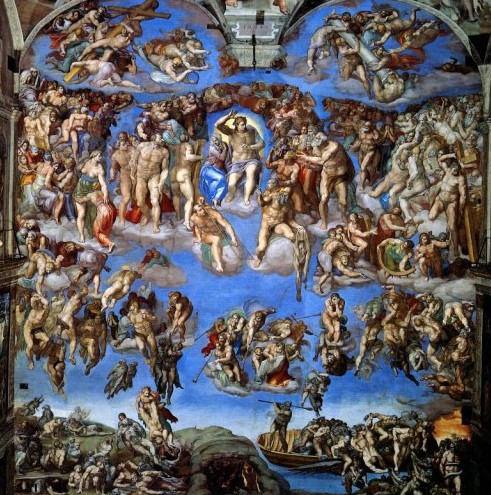
The Last Judgement, by Michelangelo (Sistine chapel)
The principal duty of pastors is to guard the purity of the faith and integrity of moral teaching, and to preserve the faithful from the dangers of error and evil. St. Charles Borromeo, as a watchful and loving shepherd, took any pains to eradicate heresy and drive heretics away from his flock, and to keep his own in the fold of Christ, the true Church, outside of which there is no salvation. He preached, instructed, reprimanded and, when necessary, punished – always mindful of his duty in the battle for salvation of souls. If we love God, we must hate the things He hates – and what He most hates is heresy and apostasy.
To their disgrace, the vast majority of modern bishops and clergy have entirely abandoned the duties of care of souls, and replaced them with secular humanist obsessions – equality, liberty (from God and His law), rights of man, immigration, economy (and then always on the leftist/socialist side). They defraud and betray the faithful by suppressing the fundamental truths of the Faith, by omitting to teach about the Commandments, sin, judgement, hell, penance, grace, and anything else unpalatable to modern hedonistic man. For these wolves in sheep’s clothes the Church is just another human institution aimed at making life on earth better, easier and more pleasant. Instead of showing souls the narrow path to heaven, they lead them on the wide, easy and well trodden road to hell.
Cardinal Borromeo never hesitated to reprove and rebuke (regardless of one’s status or power), suppress abuse, enforce discipline. He proceeded, with the severity demanded by the corruption of the age, against vice and public scandal, wherever he encountered them. Instead of giving in to the pressures of the day he fought them relentlessly – whether it was the secular government disputing his jurisdiction, the priesthood fighting his disciplinary rules, or the innovators trying to update and adjust the Church’s “obsolete” teaching.
In our age Catholics trying to hold onto their faith must daily witness the unworthy spectacle and scandal of their shepherds who embrace the errors of the world, suppress or deny the Truth, and preach the falsehood modern man wants to hear. Rather than risk unpopularity by standing with God, teaching His doctrine, and turning sinners back from their evil ways, they affirm everyone in their errors and false creeds, and so make themselves responsible for the damnation of countless souls. Where are the good pastors like St. Charles, willing to lay down their life to save souls, for whom Christ had died, from the snares of the devil?
The saint expected not only priests to be full of zeal for the salvation of souls, he endeavored to inflame all Catholics with the same desire. In his rules for Confraternities he wrote: “The workers must be very zealous for the salvation of souls, purchased by the precious Blood of our Lord Jesus Christ. This zeal will be found in them when every one makes every effort possible to prevent the loss of souls ransomed at so great a price.”
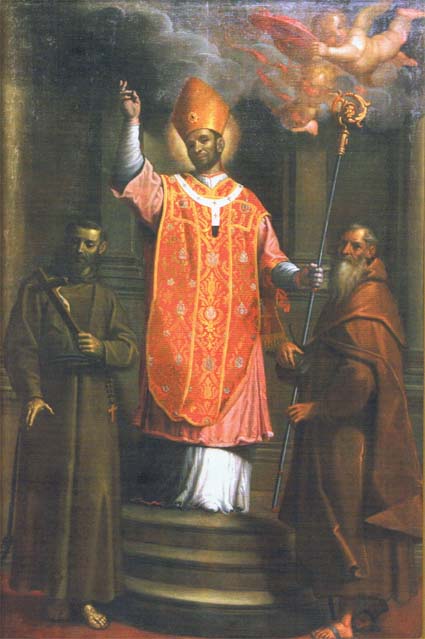
Charles Cardinal Borromeo
St. Charles had a great love for the Holy Mother Church, the Mystical Body of Christ, and never failed to defend her either against the secular powers infringing on her rights, or against destroyers who sought to bring her, and her majestic traditions, down to the perceived levels of the people. (Instead the saint showed the people how they could rise up to God.) Incensed upon seeing any impiety or lack of honor due to God, he put an end to all abuses and demanded absolute respect and reverence for holy things. Modern-age prelates and clergy not only tolerate such abominations – they are the worst perpetrators of profanation and sacrilege!
Charles Borromeo insisted people have due respect for bishops and priests, and at the same time expected his priests to behave according to the dignity of their position, censuring them if he observed any deficiency in piety, discipline or gravity of manner. He was wont to say that he suffered more from a breach of discipline committed by a priest than from all the opposition of temporal princes, and that the least harm done to the Church grieved him more than if all the tribulations in the world were to overtake himself and his family. It is therefore no surprise that the saint watchfully and tenderly guarded the young men in his seminaries; they were not only to receive good education but most importantly to become models of piety and sanctity, rooted in deep spirituality and resistant to any corruption and contagion from the world. [Is there any wonder at the appalling state of modern priesthood when seminaries have, for decades, been completely immersed in bad morals and false doctrine?]
“I am only God’s steward – to Him I shall have to account for what He has placed in my charge”, St. Charles used to say. Let us pray for our shepherds, that they may exercise their duties faithfully and with courage. God will judge them according to what they did and failed to do in their care of souls. “Woe to the pastors, that destroy and tear the sheep of my pasture, saith the Lord.” …”You have scattered my flock, and driven them away, and have not visited them: behold I will visit upon you for the evil of your doings, saith the Lord.” (Jer. 23:1-2)
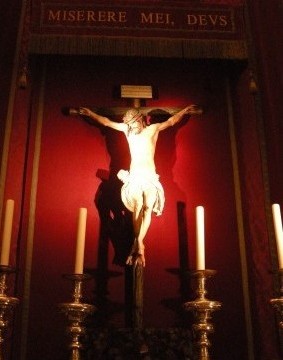
If pastors have failed to pick up St. Charles’ torch, lay Catholics faithful to Tradition must do so instead. We must never cease to proclaim the Truth and defend our Faith; we must be vigilant and denounce heresy regardless where it is found; we must neither collaborate nor compromise with the evils that permeate modern society; nor must we retreat in the face of threats, persecution, or even martyrdom. That – and nothing less – is our duty before God, Who placed us here in these dark times for a reason. Unless we take up our crosses and follow Christ – even unto crucifixion, we shall not enter His kingdom.
Sainthood can be found by anyone who keeps his eyes on the Cross. St. Charles Borromeo kept his eyes firmly on Christ and His Church, and that focus affected everything he did, and made him pleasing to the Lord. Pope Clement VIII called St. Charles a “great light of the Holy Church”. And his light continues to shine, magnificent as ever, illuminating the thorny path of all who are determined to keep the Faith and conform to the will of God.
Sancte Carole, ora pro nobis!
—
St. Charles Borromeo’s incorrupt heart is exposed in a reliquary in the beautiful baroque Basilica dei Santi Ambrogio e Carlo al Corso (also known simply as San Carlo al Corso; Via del Corso 437, Rome) built in honor of Milan’s two greatest saints. The church is also famous for its marvellous frescoes.
In Milan’s Basilica di Sant’Ambrogio, in a small museum, is a reliquary with St. Charles’ vestments scorched by the bullet of the Humiliati would-be assassin.
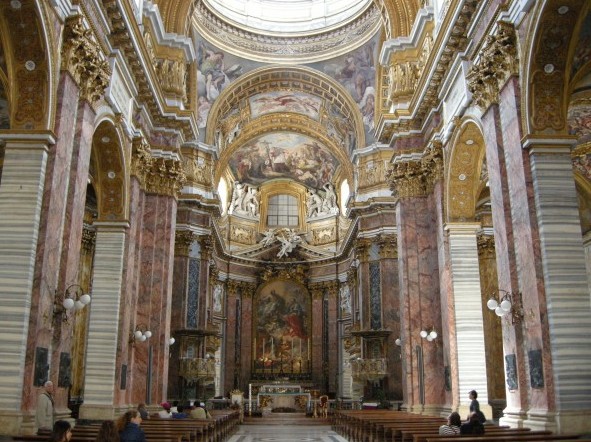
Basilica dei Santi Ambrogio e Carlo al Corso, Rome
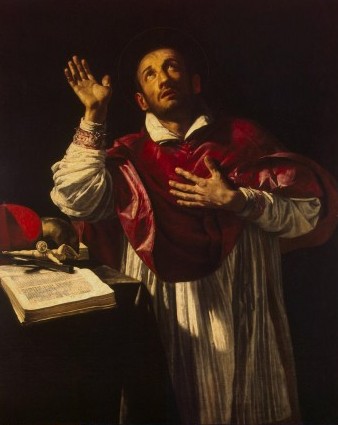
Prayer of St. Charles Borromeo
(by Orazio Borgianni)
The Life of St. Charles Borromeo, vol. I (biography by G.P. Giussano) – free download in pdf, kindle format
The Life of St. Charles Borromeo, vol II (G.P. Giussano) – pdf, kindle format
St. Charles Borromeo – A sketch of the reforming cardinal (L. Stacpoole-Kenny) – free download in pdf, kindle version
St. Charles Borromeo – A sketch of the reforming cardinal – audio version (free)

